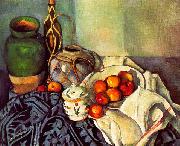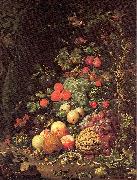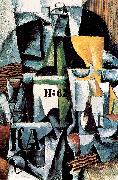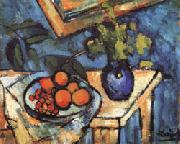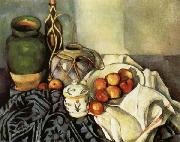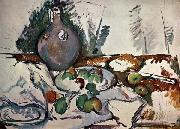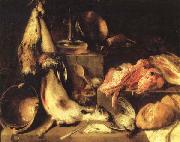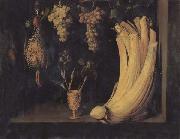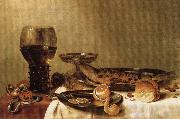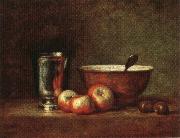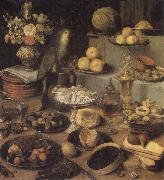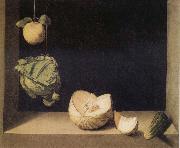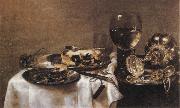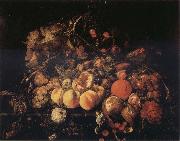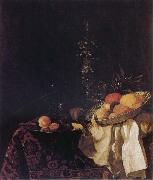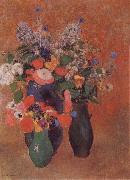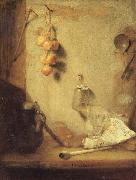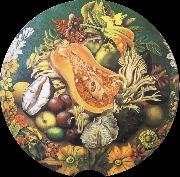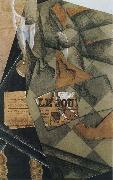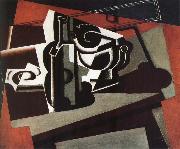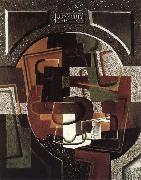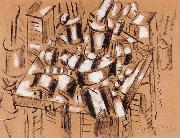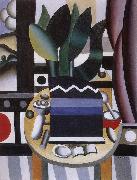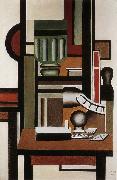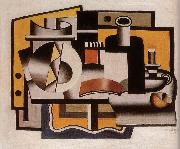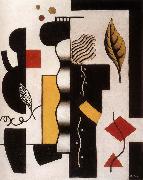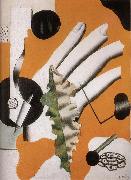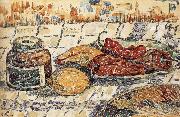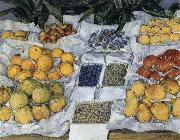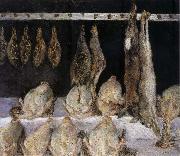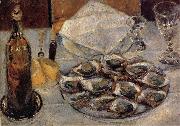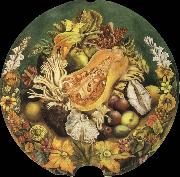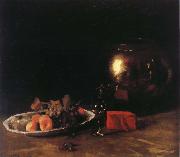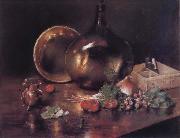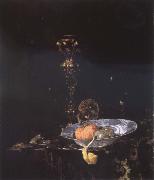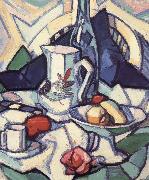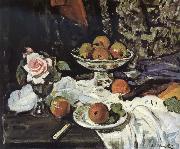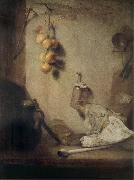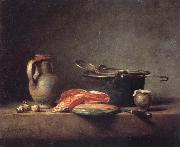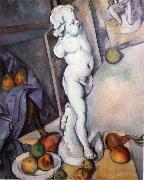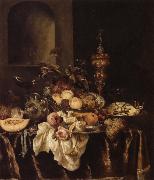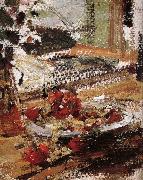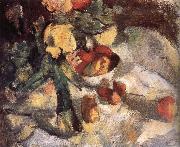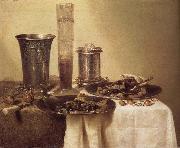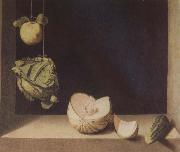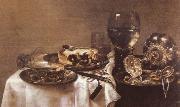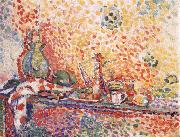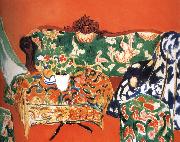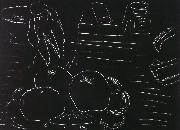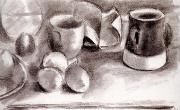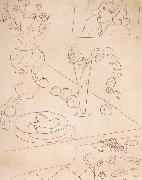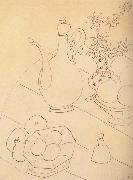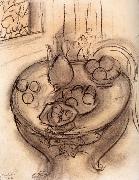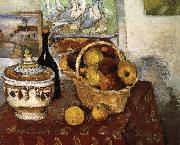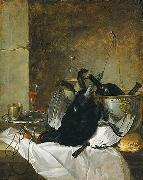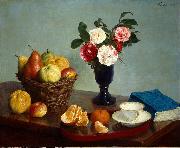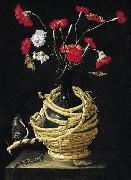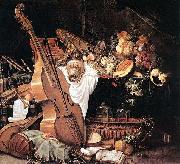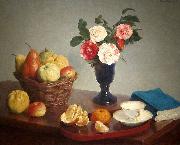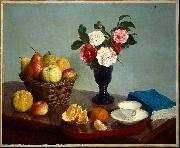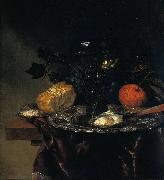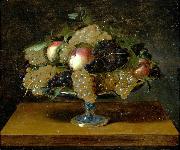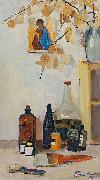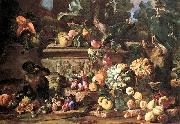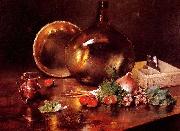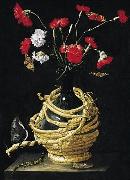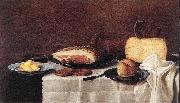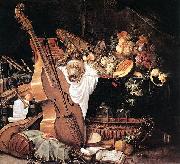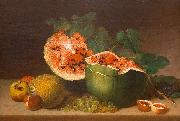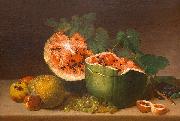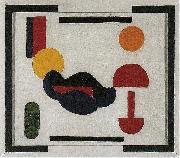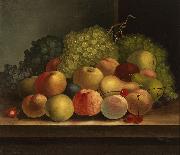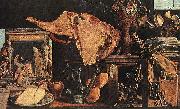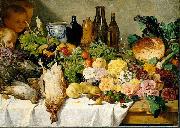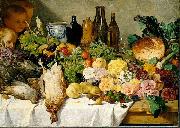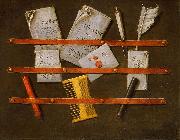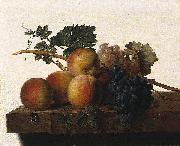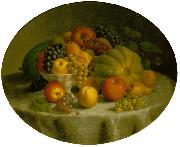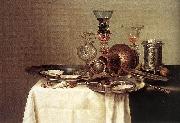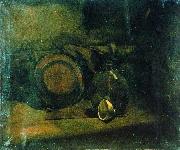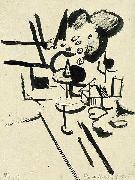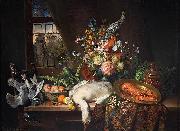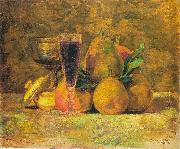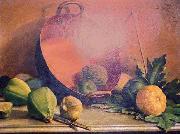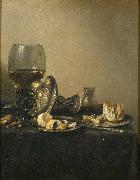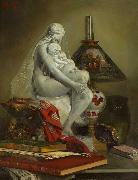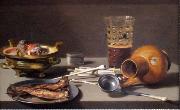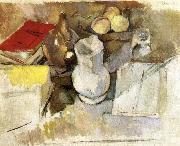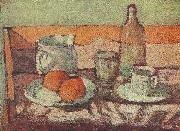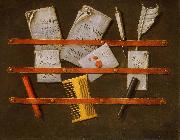Wholesale Oil Painting No Minimum |
|||||||||||
|
|
|||||||||||

|
|||||||||||
|
|
|
||||||||
Paul CezanneFrench Post-Impressionist Painter, 1839-1906 During the second half of the 19th century French impressionism created a dramatic break with the art of the past. In conception and appearance the style was radically new and, although it initially inspired public ridicule, it soon affected nearly every ambitious artist in western Europe. The new vision emerged during the 1870s, chiefly in the art of Claude Monet, Auguste Renoir, and Camille Pissarro. For each of these artists impressionism was an illusionistic style which differed from the tradition of Renaissance illusionism in its greater emphasis upon vibrant, natural color and on an immediate confrontation with the phenomena of the visible world. As the style developed during the 1880s, however, it increasingly became characterized by paintings which were flat rather than illusionistic. In other words, the impressionists insistence upon a direct application of pigment to canvas resulted in surfaces which declared themselves first of all as surfaces - and, consequently, in paintings which declared themselves first of all as paintings rather than as windows which looked out upon the natural world. The tendency toward flatness persisted into the last years of the 19th century, its pervasiveness giving the impression that illusionistic space - fought for, won, and defended since the very beginning of the Renaissance - had finally been sacrificed by the medium of painting. Paul C??zanne worked within and finally emerged from this trend. As a painter, he matured slowly, his greatest works coming during the last 25 years of his life. During this period he scored a remarkable and heroic achievement: he restored to painting the space and volume that had seemingly been lost to it. But he did it in a totally unprecedented way: not by return to the illusionism of the past but by the creation of a spatial illusionism that did not violate flatness. C??zanne was born on Jan. 19, 1839, in Aix-en-Provence. His father, Philippe Auguste, was the cofounder of a banking firm which prospered throughout the artist life, affording him financial security that was unavailable to most of his contemporaries and eventually resulting in a large inheritance. In 1852 C??zanne entered the Coll??ge Bourbon, where he met and became friends with Émile Zola. This friendship was decisive for both men: with youthful romanticism they envisioned successful careers in the Paris art world, C??zanne as a painter and Zola as a writer. Consequently, C??zanne began to study painting and drawing at the École des Beaux-Arts in Aix in 1856. His father opposed the pursuit of an artistic career, and in 1858 he persuaded C??zanne to enter law school at the University of Aix. Although C??zanne continued his law studies for several years, he was simultaneously enrolled in the School of Design in Aix, where he remained until 1861. In 1861 C??zanne finally convinced his father to allow him to go to Paris. He planned to join Zola there and to enroll in the École des Beaux-Arts. But his application was rejected and, although he had gained inspiration from visits to the Louvre, particularly from the study of Diego Vel??zquez and Caravaggio, C??zanne experienced self-doubt and returned to Aix within the year. He entered his father banking house but continued to study at the School of Design. The remainder of the decade was a period of flux and uncertainty for C??zanne. His attempt to work in his father business was abortive, and he returned to Paris in 1862 and stayed for a year and a half. During this period he met Monet and Pissarro and became acquainted with the revolutionary work of Gustave Courbet and Édouard Manet. C??zanne also admired the fiery romanticism of Eug??ne Delacroix paintings. But he was never entirely comfortable with Parisian life and periodically returned to Aix, where he could work in relative isolation. He retreated there, for instance, during the Franco-Prussian War (1870-1871). |
||||||||
|
|
||||||||
Still Life
Still Life Painting ID:: 369 |
1890-94 1890-94 |
|||||||
|
|
||||||||
MIGNON, AbrahamDutch Baroque Era Painter, 1640-1679 Dutch painter, was born at Frankfurt. His father, a merchant, placed him under the still-life painter Jacob Marrel, by whom he was taken to the Netherlands about 1660. He then worked under Jan Davidszoon de Heem at Utrecht, where in 1675 he married the daughter of the painter Cornelis Willaerts. Sibylle Merian (1647-1717), daughter of the engraver Matthew Merian, became his pupil and achieved distinction as a flower painter. He died at Utrecht. Mignon devoted himself almost exclusively to flowers, fruit, birds and other still-life, though at times he also attempted portraiture. His flower pieces are marked by careful finish and delicate handling. His favourite scheme was to introduce red or white roses in the centre of the canvas and to set the whole group of flowers against a dark background. Nowhere can his work be seen to better advantage than at the Dresden Gallery, which contains fifteen of his paintings, twelve of which are signed. Six of his pictures are at the Louvre, four at the Hermitage, and other examples are to be found at the museums of Amsterdam, |
||||||||
|
|
||||||||
|
|
Still Life
Still Life Painting ID:: 19434 |
Undated
Oil on canvas
Wallraf-Richartz-Museum, Cologne. Undated Oil on canvas Wallraf-Richartz-Museum, Cologne. |
||||||
|
|
||||||||
Popova, LiubovRussian Constructivist Painter and Designer, 1889-1924 |
||||||||
|
|
||||||||
|
|
Still Life
Still Life Painting ID:: 19913 |
Russian Constructivist Painter and Designer, 1889-1924 Russian Constructivist Painter and Designer, 1889-1924 |
||||||
|
|
||||||||
Maurice de Vlaminckmaurice de vlaminck,1876 to 1958,French painter, printmaker, draughtsman and writer. His nature, character, tastes and way of life were in perfect harmony with the freedom, daring and violence of his painting. He was brought up in a musical environment: his father, of Flemish origin, was a violin teacher and his mother, from Lorraine, was a piano teacher. He studied music himself to quite a high standard and later played the double-bass (and sometimes the bass drum, a source of considerable pleasure) in his regimental band. His family had come to live at Le V?sinet near Paris, and he spent his childhood both there and later at Chatou on the Seine. From 1892 he began to take an interest in painting, though he worked as a mechanic and became a racing cyclist. |
||||||||
|
|
||||||||
|
|
Still Life
Still Life Painting ID:: 11889 |
ca 1910
1' 9 1/4'' x 2' 1 1/2''(54 x 64.5 cm)Gift of Max and Rosy Kaganovitch,1973 ca 1910 1' 9 1/4'' x 2' 1 1/2''(54 x 64.5 cm)Gift of Max and Rosy Kaganovitch,1973 |
||||||
|
|
||||||||
Paul CezanneFrench Post-Impressionist Painter, 1839-1906 During the second half of the 19th century French impressionism created a dramatic break with the art of the past. In conception and appearance the style was radically new and, although it initially inspired public ridicule, it soon affected nearly every ambitious artist in western Europe. The new vision emerged during the 1870s, chiefly in the art of Claude Monet, Auguste Renoir, and Camille Pissarro. For each of these artists impressionism was an illusionistic style which differed from the tradition of Renaissance illusionism in its greater emphasis upon vibrant, natural color and on an immediate confrontation with the phenomena of the visible world. As the style developed during the 1880s, however, it increasingly became characterized by paintings which were flat rather than illusionistic. In other words, the impressionists insistence upon a direct application of pigment to canvas resulted in surfaces which declared themselves first of all as surfaces - and, consequently, in paintings which declared themselves first of all as paintings rather than as windows which looked out upon the natural world. The tendency toward flatness persisted into the last years of the 19th century, its pervasiveness giving the impression that illusionistic space - fought for, won, and defended since the very beginning of the Renaissance - had finally been sacrificed by the medium of painting. Paul C??zanne worked within and finally emerged from this trend. As a painter, he matured slowly, his greatest works coming during the last 25 years of his life. During this period he scored a remarkable and heroic achievement: he restored to painting the space and volume that had seemingly been lost to it. But he did it in a totally unprecedented way: not by return to the illusionism of the past but by the creation of a spatial illusionism that did not violate flatness. C??zanne was born on Jan. 19, 1839, in Aix-en-Provence. His father, Philippe Auguste, was the cofounder of a banking firm which prospered throughout the artist life, affording him financial security that was unavailable to most of his contemporaries and eventually resulting in a large inheritance. In 1852 C??zanne entered the Coll??ge Bourbon, where he met and became friends with Émile Zola. This friendship was decisive for both men: with youthful romanticism they envisioned successful careers in the Paris art world, C??zanne as a painter and Zola as a writer. Consequently, C??zanne began to study painting and drawing at the École des Beaux-Arts in Aix in 1856. His father opposed the pursuit of an artistic career, and in 1858 he persuaded C??zanne to enter law school at the University of Aix. Although C??zanne continued his law studies for several years, he was simultaneously enrolled in the School of Design in Aix, where he remained until 1861. In 1861 C??zanne finally convinced his father to allow him to go to Paris. He planned to join Zola there and to enroll in the École des Beaux-Arts. But his application was rejected and, although he had gained inspiration from visits to the Louvre, particularly from the study of Diego Vel??zquez and Caravaggio, C??zanne experienced self-doubt and returned to Aix within the year. He entered his father banking house but continued to study at the School of Design. The remainder of the decade was a period of flux and uncertainty for C??zanne. His attempt to work in his father business was abortive, and he returned to Paris in 1862 and stayed for a year and a half. During this period he met Monet and Pissarro and became acquainted with the revolutionary work of Gustave Courbet and Édouard Manet. C??zanne also admired the fiery romanticism of Eug??ne Delacroix paintings. But he was never entirely comfortable with Parisian life and periodically returned to Aix, where he could work in relative isolation. He retreated there, for instance, during the Franco-Prussian War (1870-1871). |
||||||||
|
|
||||||||
|
|
Still Life
Still Life Painting ID:: 27766 |
mk62
1890-1894
Oil on canvas
65.5x81.5cm
on loan to the Kunsthaus Zurich
mk62 1890-1894 Oil on canvas 65.5x81.5cm on loan to the Kunsthaus Zurich |
||||||
|
|
||||||||
Paul CezanneFrench Post-Impressionist Painter, 1839-1906 During the second half of the 19th century French impressionism created a dramatic break with the art of the past. In conception and appearance the style was radically new and, although it initially inspired public ridicule, it soon affected nearly every ambitious artist in western Europe. The new vision emerged during the 1870s, chiefly in the art of Claude Monet, Auguste Renoir, and Camille Pissarro. For each of these artists impressionism was an illusionistic style which differed from the tradition of Renaissance illusionism in its greater emphasis upon vibrant, natural color and on an immediate confrontation with the phenomena of the visible world. As the style developed during the 1880s, however, it increasingly became characterized by paintings which were flat rather than illusionistic. In other words, the impressionists insistence upon a direct application of pigment to canvas resulted in surfaces which declared themselves first of all as surfaces - and, consequently, in paintings which declared themselves first of all as paintings rather than as windows which looked out upon the natural world. The tendency toward flatness persisted into the last years of the 19th century, its pervasiveness giving the impression that illusionistic space - fought for, won, and defended since the very beginning of the Renaissance - had finally been sacrificed by the medium of painting. Paul C??zanne worked within and finally emerged from this trend. As a painter, he matured slowly, his greatest works coming during the last 25 years of his life. During this period he scored a remarkable and heroic achievement: he restored to painting the space and volume that had seemingly been lost to it. But he did it in a totally unprecedented way: not by return to the illusionism of the past but by the creation of a spatial illusionism that did not violate flatness. C??zanne was born on Jan. 19, 1839, in Aix-en-Provence. His father, Philippe Auguste, was the cofounder of a banking firm which prospered throughout the artist life, affording him financial security that was unavailable to most of his contemporaries and eventually resulting in a large inheritance. In 1852 C??zanne entered the Coll??ge Bourbon, where he met and became friends with Émile Zola. This friendship was decisive for both men: with youthful romanticism they envisioned successful careers in the Paris art world, C??zanne as a painter and Zola as a writer. Consequently, C??zanne began to study painting and drawing at the École des Beaux-Arts in Aix in 1856. His father opposed the pursuit of an artistic career, and in 1858 he persuaded C??zanne to enter law school at the University of Aix. Although C??zanne continued his law studies for several years, he was simultaneously enrolled in the School of Design in Aix, where he remained until 1861. In 1861 C??zanne finally convinced his father to allow him to go to Paris. He planned to join Zola there and to enroll in the École des Beaux-Arts. But his application was rejected and, although he had gained inspiration from visits to the Louvre, particularly from the study of Diego Vel??zquez and Caravaggio, C??zanne experienced self-doubt and returned to Aix within the year. He entered his father banking house but continued to study at the School of Design. The remainder of the decade was a period of flux and uncertainty for C??zanne. His attempt to work in his father business was abortive, and he returned to Paris in 1862 and stayed for a year and a half. During this period he met Monet and Pissarro and became acquainted with the revolutionary work of Gustave Courbet and Édouard Manet. C??zanne also admired the fiery romanticism of Eug??ne Delacroix paintings. But he was never entirely comfortable with Parisian life and periodically returned to Aix, where he could work in relative isolation. He retreated there, for instance, during the Franco-Prussian War (1870-1871). |
||||||||
|
|
||||||||
|
|
Still Life
Still Life Painting ID:: 27939 |
mk62
c.1892-4
Oil on canvas
53x71cm
Tate Gallery.London
mk62 c.1892-4 Oil on canvas 53x71cm Tate Gallery.London |
||||||
|
|
||||||||
Mateo cerezoSpanish gifted painter and colorist , c.1626-1666 |
||||||||
|
|
||||||||
|
|
Still Life
Still Life Painting ID:: 28050 |
mk61
c.1666
Oil on canvas
100x127cm
mk61 c.1666 Oil on canvas 100x127cm |
||||||
|
|
||||||||
Felipe RamirezSpanish painter (documented 1628-1631 in Toledo). |
||||||||
|
|
||||||||
|
|
Still Life
Still Life Painting ID:: 28053 |
mk61
1628
Oil on canvas
71x92cm
mk61 1628 Oil on canvas 71x92cm |
||||||
|
|
||||||||
HEDA, Willem Claesz.Dutch painter (b. 1594, Haarlem, d. 1680, Haarlem). Dutch still-life painter. His excellent studies of tables laden with food, called ontbijt still life, are seen in many important European galleries. They are characterized by delicate lighting effects and somber colors. |
||||||||
|
|
||||||||
|
|
Still Life
Still Life Painting ID:: 30552 |
mk68
Oil on wood
The Hague
Mauritshuis
1629
Netherlands
mk68 Oil on wood The Hague Mauritshuis 1629 Netherlands |
||||||
|
|
||||||||
Francisco de Zurbaran1598-1664 Spanish Francisco de Zurbaran Galleries Spanish baroque painter, active mainly at Llerena, Madrid, and Seville. He worked mostly for ecclesiastical patrons. His early paintings, including Crucifixion (1627; Art Inst., Chicago), St. Michael (Metropolitan Mus.), and St. Francis (City Art Museum, St. Louis), often suggest the austere simplicity of wooden sculpture. The figures, placed close to the picture surface, are strongly modeled in dramatic light against dark backgrounds, indicating the influence of Caravaggio. They were clearly painted as altarpieces or devotional objects. In the 1630s the realistic style seen in his famous Apotheosis of St. Thomas Aquinas (1631; Seville) yields to a more mystical expression in works such as the Adoration of the Shepherds (1638; Grenoble); in this decade he was influenced by Ribera figural types and rapid brushwork. While in Seville, Zurbur??n was clearly influenced by Velazquez. After c.1640 the simple power of Zurbaran work lessened as Murillo influence on his painting increased (e.g., Virgin and Child with St. John, Fine Arts Gall., San Diego, Calif.). There are works by Zurbar??n in the Hispanic Society of America, New York City; the National Gallery, Washington, D.C.; and the Philadelphia Museum of Art.. |
||||||||
|
|
||||||||
|
|
Still Life
Still Life Painting ID:: 30562 |
mk68
Oil on canvas
18"x33"
1633-1640
Spain
mk68 Oil on canvas 18"x33" 1633-1640 Spain |
||||||
|
|
||||||||
jean-Baptiste-Simeon Chardin1699-1779 was an 18th-century French painter. He is considered a master of still life.Chardin was born in Paris, the son of a cabinetmaker, and rarely left the city. He lived on the Left Bank near Saint-Sulpice until 1757, when Louis XV granted him a studio and living quarters in the Louvre.Chardin entered into a marriage contract with Marguerite Saintard in 1723, whom he did not marry until 1731.He served apprenticeships with the history painters Pierre-Jacques Cazes and Noël-Nicholas Coypel, and in 1724 became a master in the Academie de Saint-Luc. Upon presentation of The Ray in 1728, he was admitted to the Academie Royale de Peinture et de Sculpture. The following year he ceded his position in the Academie de Saint-Luc. In November of 1731 his son Jean-Pierre was baptized, and a daughter, Marguerite-Agn's, was baptized in 1733. In 1735 his wife Marguerite died, and within two years Marguerite-Agn's had died as well.Beginning in 1737 Chardin exhibited regularly at the Salon. He would prove to be a 'dedicated academician', regularly attending meetings for fifty years, and functioning successively as counsellor, treasurer, and secretary, overseeing in 1761 the installation of Salon exhibitions. In 1744 he entered his second marriage, this time to Françoise-Marguerite Pouget. The following year a daughter, Angelique-Françoise, was born, but she died in 1746. In 1752 Chardin was granted a pension of 500 livres by Louis XV. At the Salon of 1759 he exhibited nine paintings; it was the first Salon to be commented upon by Denis Diderot, who would prove to be a great admirer and public champion of Chardin's work.Beginning in 1761, his responsibilities on behalf of the Salon, simultaneously arranging the exhibitions and acting as treasurer, resulted in a diminution of productivity in painting, and the showing of 'replicas' of previous works.In 1763 his services to the Academie were acknowledged with an extra 200 livres in pension. In 1765 he was unanimously elected associate member of the Academie des Sciences, Belles-Lettres et Arts of Rouen, but there is no evidence that he left Paris to accept the honor.By 1770 Chardin was the 'Premiere peintre du roi', and his pension of 1,400 livres was the highest in the Academy.In 1772 Chardin's son, |
||||||||
|
|
||||||||
|
|
Still Life
Still Life Painting ID:: 30627 |
mk68
Oil on canvas
Paris,Louvre
1763
France
mk68 Oil on canvas Paris,Louvre 1763 France |
||||||
|
|
||||||||
Francisco de Zurbaran1598-1664 Spanish Francisco de Zurbaran Galleries Spanish baroque painter, active mainly at Llerena, Madrid, and Seville. He worked mostly for ecclesiastical patrons. His early paintings, including Crucifixion (1627; Art Inst., Chicago), St. Michael (Metropolitan Mus.), and St. Francis (City Art Museum, St. Louis), often suggest the austere simplicity of wooden sculpture. The figures, placed close to the picture surface, are strongly modeled in dramatic light against dark backgrounds, indicating the influence of Caravaggio. They were clearly painted as altarpieces or devotional objects. In the 1630s the realistic style seen in his famous Apotheosis of St. Thomas Aquinas (1631; Seville) yields to a more mystical expression in works such as the Adoration of the Shepherds (1638; Grenoble); in this decade he was influenced by Ribera figural types and rapid brushwork. While in Seville, Zurbur??n was clearly influenced by Velazquez. After c.1640 the simple power of Zurbaran work lessened as Murillo influence on his painting increased (e.g., Virgin and Child with St. John, Fine Arts Gall., San Diego, Calif.). There are works by Zurbar??n in the Hispanic Society of America, New York City; the National Gallery, Washington, D.C.; and the Philadelphia Museum of Art.. |
||||||||
|
|
||||||||
|
|
Still Life
Still Life Painting ID:: 32879 |
mk84
1633
Pasadena,Norton Simon Museum of Art,
canvas
60x107cm
mk84 1633 Pasadena,Norton Simon Museum of Art, canvas 60x107cm |
||||||
|
|
||||||||
Georg Flegel1566-1638 Georg Flegel Location German painter. He was the son of a shoemaker, and not being a Roman Catholic, probably moved to Vienna after 1580, when the Counter-Reformation began to take effect in Olmetz. In Vienna he became the assistant of Lucas van Valckenborch I, whom he subsequently followed to Frankfurt, then an important centre for art dealing and publishing. He filled in staffage in van Valckenborch pictures of the seasons and portraits, inserting fruit, table utensils and flowers as still-life set pieces. His faithful reproduction of flowers and fruit drew on watercolours by Derer, still-life painters from the Netherlands living in Frankfurt, and botanical and zoological illustrations by Joris Hoefnagel, Pieter van der Borcht IV and Carolus Clusius (1525-1609) then being published in Frankfurt. |
||||||||
|
|
||||||||
|
|
Still Life
Still Life Painting ID:: 33619 |
mk86
undated
Oil on copper
78x67cm
Munich,Bayerische Staatsgemalde-Sammlungen,Alt Pinakothek
mk86 undated Oil on copper 78x67cm Munich,Bayerische Staatsgemalde-Sammlungen,Alt Pinakothek |
||||||
|
|
||||||||
Juan Sanchez-CotanSpanish 1561-1627 S??nchez Cot??n was born in the town of Orgaz, near Toledo. He was a friend and perhaps pupil of Blas de Prado, an artist famous for his still lifes whose mannerist style with touches of realism, the disciple developed further. Cot??n began by painting altar pieces and religious works. For approximately twenty years, he pursued a successful career in Toledo as an artist, patronized by the city??s aristocracy, painting religious scenes, portraits and still lifes. These paintings found a receptive audience among the educated intellectuals of Toledo society. S??nchez Cot??n executed his notable still lifes around the turn of the seventeenth century, before the end of his secular life. An example (seen above) is Quince, Cabbage, Melon and Cucumber (1602, in the San Diego Museum of Art). On August 10, 1603, Juan Sanchez Cotan, then in his forties, closed up his workshop at Toledo to renounce the world and enter the Carthusian monastery Santa Maria de El Paular. He continued his career painting religious works with singular mysticism. In 1612 he was sent to the Granada Charterhouse, he decided to become a monk, and in the following year he entered the Carthusian monastery at Granada as a laybrother. The reasons for this are not clear, though such action was not unusual in Cot??n??s day. Cotan was a prolific religious painter whose work, carried out exclusively for his monastery, reached its peak about 1617 in the cycle of eight great narrative paintings which he painted for the cloister of the Granada Monastery. These depict the foundation of the order of St. Bruno, and the prosecution of the monks in England by the Protestants. Although the painter??s religious works have an archaic air, they also reveal a keen interest in the treatment of light and volumes, and in some respect are comparable with certain works by the Italian Luca Cambiaso whom Cotan knew at the Escorial. While Cotan's religious works are unexceptional, as a still-life painter he ranks with the great names of European painting. In spite of his retreat from the world, Cotan??s influence remained strong. His concern with the relationships among objects and with achieving the illusion of reality through the use of light and shadow was a major influence on the work of later Spanish painters such as Juan van der Hamen, Felipe Ramirez, the brothers Vincenzo and Bartolomeo Carducci and, notably, Francisco de Zurbaran. Sanchez Cotan ended his days universally loved and regarded as a saint. He died in 1627 in Granada. |
||||||||
|
|
||||||||
|
|
Still Life
Still Life Painting ID:: 33625 |
mk86
c.1602
Oil on canvas
65x81cm
mk86 c.1602 Oil on canvas 65x81cm |
||||||
|
|
||||||||
Frans SnydersBelgian 1579-1657 Frans Snyders Gallery Frans Snyders (1579 - 1657), or Snijders, was a Flemish painter of animals and still life. Snyders was born and died at Antwerp. He is recorded as a student of Pieter Brueghel the Younger in 1593, and subsequently received instruction from Hendrick van Balen, the first master of Van Dyck. He was a friend of Van Dyck who painted Snyders and his wife more than once (Frick Collection, Kassel etc). He became a master of the Antwerp painters guild in 1602. He visited Italy in 1608-9, visiting Rome, and working for Cardinal Borromeo in Milan. In 1611 he married Margaretha, the sister of Cornelis de Vos and Paul de Vos (another animal painter), in Antwerp. Jan Fyt was a student, and then assistant of his from 1629. Snyders initially devoted himself to painting flowers, fruit and subjects of still life, but later turned to painting animals, and executed with the greatest skill and spirit hunting pieces and combats of wild animals. He was one of the earliest specialist animaliers. Snyders and his wife, by Van Dyck, KasselHis composition is rich and varied, his drawing correct and vigorous, his touch bold and thoroughly expressive of the different textures of furs and skins. His excellence in this department excited the admiration of Rubens, who frequently employed him to paint animals, fruit and still life in his own pictures, and he assisted Jacob Jordaens, Thomas Willeboirts Bosschaert and other artists in a similar manner. In the lion and boar hunts which bear the name of Snyders the hand of Rubens sometimes appears. He was one of the executors of Rubens's will. He was appointed principal painter to the Archduke Albert of Austria, governor of the Low Countries, for whom he executed some of his finest works. One of these, a Stag-Hunt was presented to Philip III of Spain, who together with his successor Philip IV of Spain, commissioned the artist to paint several subjects of the chase, which are still preserved in Spain. He also worked for Archduke Leopold Wilhelm of Austria, when he became Governor. |
||||||||
|
|
||||||||
|
|
Still Life
Still Life Painting ID:: 33680 |
mk86
1614
Oil on canvas
156x218cm
Cologne,Wallraf-Richartz-Musuem mk86 1614 Oil on canvas 156x218cm Cologne,Wallraf-Richartz-Musuem |
||||||
|
|
||||||||
Willem Claesz Heda1594-1682 Dutch Willem Claesz Heda Galleries Dutch painter. He was a still-life painter, who, like Pieter Claesz., is noted for his monochrome breakfast-pieces, which are, however, more opulent than those of Claesz. Heda earliest dated work is a Vanitas (1621; The Hague, Mus. Bredius), which shows a still-life from a high viewpoint, composed of various objects bearing vanitas associations (e.g. a bowl of glowing embers, smoker requisites, an overturned glass and a skull); the colouring is in brownish-grey tones and represents one of the earliest examples of a Dutch monochrome still-life (monochrome refers to the range of tones, rather than of colours). Even in this early work Heda skill at painting textures is evident. A more balanced composition is achieved in another Still-life (1629; The Hague, Mauritshuis) and in the Breakfast Table (1631; Dresden, Gemeldegal. Alte Meister), in both of which the objects, set against a neutral background, are linked by a strong diagonal. The Mauritshuis still-life also gives an early indication of Heda interest in painting the effects of light. In 1631 he became a member of the Haarlem Guild of St Luke (of which he served as deacon on several occasions after 1637). |
||||||||
|
|
||||||||
|
|
Still Life
Still Life Painting ID:: 33688 |
mk86
1631
Oil on panel54x82cm
Dresden,Gemaldegalerie Alte Meister
mk86 1631 Oil on panel54x82cm Dresden,Gemaldegalerie Alte Meister |
||||||
|
|
||||||||
Jan Davidsz. de Heemstilllife masters, Dutch Baroque Era Painter, 1606-C.1683 |
||||||||
|
|
||||||||
|
|
Still Life
Still Life Painting ID:: 33711 |
mk86
undated
Oil on panel
55.8x73.5cm
Gent ,Museum voor Schone Kunsten
mk86 undated Oil on panel 55.8x73.5cm Gent ,Museum voor Schone Kunsten |
||||||
|
|
||||||||
Willem Kalf1619-1693 Dutch Willem Kalf Galleries Willem Kalf was born in Rotterdam, in 1619. He was previously thought to have been born in 1622, but H. E. van Gelder??s important archival research has established the painter??s correct place and date of birth. Kalf was born into a prosperous patrician family in Rotterdam, where his father, a cloth merchant, held municipal posts as well. In the late 1630s, Willem Kalf travelled to Paris and spent time in the circle of the Flemish artists in Saint-Germain-des-Pr??s, Paris. In Paris he painted mainly small-scale rustic interiors and still-lifes. Kalf??s rustic interiors are typically dominated by groups of vegetables, buckets, pots and pans, which he arranged as a still-life in the foreground (e.g. Kitchen Still-life, Dresden, Gemäldegal; Alte Meister). Figures usually appeared only in the blurred obscurity of the background. Though painted in Paris, those pictures belong to a pictorial tradition practised primarily in Flanders in the early 17th century, by such artists as David Teniers the Younger. The only indication of the French origin of the paintings are a few objects that Flemish exponents of the same genre would not have pictured in their works. Kalf??s rustic interiors had a large influence on French art in the circle of the Le Nain brothers. The semi-monochrome still-lifes which Kalf created in Paris form a link to the banketjes or 'little banquet pieces' painted by such Dutch artists as Pieter Claesz, Willem Claeszoon Heda and others in the 1630s. During the 1640s, Kalf further developed the banketje into a novel form of sumptuous and ornate still-life (known as pronkstilleven), depicting rich groupings of gold and silver vessels. Like other still-lifes of this period, these paintings were usually expressing vanitas allegories. |
||||||||
|
|
||||||||
|
|
Still Life
Still Life Painting ID:: 33721 |
mk86
c.1653/1654
Oil on canvas
105x87.5cm
St Petersburg,Hermitage
mk86 c.1653/1654 Oil on canvas 105x87.5cm St Petersburg,Hermitage |
||||||
|
|
||||||||
Samuel van hoogstratenDutch Baroque Era Painter, 1627-1678 Dutch portrait painter and etcher, studied with his father, Dirk van Hoogstraten (1596?C1640), and with Rembrandt. His best works, such as The Old Jew (Vienna), reflect the influence of Rembrandt. He was director of the Academy in Dordrecht and author of a treatise (1678) in which he analyzed the theory and practice of the art of Rembrandt and other artists of the period. |
||||||||
|
|
||||||||
|
|
Still Life
Still Life Painting ID:: 33732 |
mk86
c.1666-1668
Oil on canvas
63x79cm
Karlsruhe,Staatliche Kunsthalle mk86 c.1666-1668 Oil on canvas 63x79cm Karlsruhe,Staatliche Kunsthalle |
||||||
|
|
||||||||
Henri Fantin-LatourFrench 1836-1904 Henri Fantin Latour Locations Bure) French painter and printmaker. He was trained by his father, a portrait painter, and at the Ecole des Beaux-Arts. Though he associated with progressive artists (Gustave Courbet, Eugene Delacroix, Edouard Manet), he was a traditionalist best known for his portraits and still lifes with flowers. His portrait groups, reminiscent of 17th-century Dutch guild portraits, depict literary and artistic persons of the time; his flower paintings were especially popular in England, thanks to James McNeill Whistler and John Everett Millais, who found patrons to support him. His later years were devoted to lithography. |
||||||||
|
|
||||||||
|
|
Still Life
Still Life Painting ID:: 33965 |
mk87
1869
Oil on canvas
32x29.5cm
Grenoble,Musee de Peinture et de Sculpture
mk87 1869 Oil on canvas 32x29.5cm Grenoble,Musee de Peinture et de Sculpture |
||||||
|
|
||||||||
Odilon RedonFrench Symbolist Painter, 1840-1916 Bertrand-Jean Redon, better known as Odilon Redon (April 20, 1840 ?C July 6, 1916) was a Symbolist painter and printmaker, born in Bordeaux, Aquitaine, France. Odilon was a nickname derived from his mother, Odile. Redon started drawing as a young child, and at the age of 10 he was awarded a drawing prize at school. At age 15, he began formal study in drawing but on the insistence of his father he switched to architecture. His failure to pass the entrance exams at Paris?? Ecole des Beaux-Arts ended any plans for a career as an architect, although he would later study there under Jean-L??on Gerôme. Back home in his native Bordeaux, he took up sculpture, and Rodolphe Bresdin instructed him in etching and lithography. However, his artistic career was interrupted in 1870 when he joined the army to serve in the Franco-Prussian War. At the end of the war, he moved to Paris, working almost exclusively in charcoal and lithography. It would not be until 1878 that his work gained any recognition with Guardian Spirit of the Waters, and he published his first album of lithographs, titled Dans le R??ve, in 1879. Still, Redon remained relatively unknown until the appearance in 1884 of a cult novel by Joris-Karl Huysmans titled, À rebours (Against Nature). The story featured a decadent aristocrat who collected Redon's drawings. In the 1890s, he began to use pastel and oils, which dominated his works for the rest of his life. In 1899, he exhibited with the Nabis at Durand-Ruel's. In 1903 he was awarded the Legion of Honor. His popularity increased when a catalogue of etchings and lithographs was published by Andr?? Mellerio in 1913 and that same year, he was given the largest single representation at the New York Armory Show. In 1923 Mellerio published: Odilon Redon: Peintre Dessinateur et Graveur. An archive of Mellerio's papers is held by the Ryerson & Burnham Libraries at the Art Institute of Chicago. In 2005 the Museum of Modern Art launched an exhibition entitled "Beyond The Visible", a comprehensive overview of Redon's work showcasing more than 100 paintings, drawings, prints and books from The Ian Woodner Family Collection. The exhibition ran from October 30, 2005 to January 23, 2006. |
||||||||
|
|
||||||||
|
|
Still Life
Still Life Painting ID:: 33986 |
mk87
c.1910
Oil on canvas
73x54cm
Wuppertal,Von der Heydt-Museum
mk87 c.1910 Oil on canvas 73x54cm Wuppertal,Von der Heydt-Museum |
||||||
|
|
||||||||
Christoph PaudissGerman,Christoph Paudiss, ca.1618-1666 |
||||||||
|
|
||||||||
|
|
Still Life
Still Life Painting ID:: 34271 |
mk91
1660
Oil on canvas
Transferred from a panel
62x46.5
mk91 1660 Oil on canvas Transferred from a panel 62x46.5 |
||||||
|
|
||||||||
Frida Kahlo1907-54 Mexican painter, b. Coyoacen. As a result of an accident at age 15, Kahlo turned her attention from a medical career to painting. Drawing on her personal experiences, her works are often shocking in their stark portrayal of pain and the harsh lives of women. Fifty-five of her 143 paintings are self-portraits incorporating a personal symbolism complete with graphic anatomical references. She was also influenced by indigenous Mexican culture, aspects of which she portrayed in bright colors, with a mixture of realism and symbolism. Her paintings attracted the attention of the artist Diego Rivera, whom she later married. Although Kahlo's work is sometimes classified as surrealist and she did exhibit several times with European surrealists, she herself disputed the label. Her preoccupation with female themes and the figurative candor with which she expressed them made her something of a feminist cult figure in the last decades of the 20th cent. |
||||||||
|
|
||||||||
|
|
Still Life
Still Life Painting ID:: 35624 |
mk104
1942
Oil on copper
24.8 in diameter
mk104 1942 Oil on copper 24.8 in diameter |
||||||
|
|
||||||||
Nicolas de StaelRussian Painter.1914-1955 was a painter known for his use of a thick impasto and his highly abstract landscape painting. He also worked with collage, illustration and textiles Nocolas de Stael was born in the family of a Russian Lieutenant General, Baron Vladimir Stael von Holstein, (a member of the Stael von Holstein family, and the last Commandant of the Peter and Paul Fortress) and his wife, Olga Sakhanskaya. De Stael's family was forced to emigrate to Poland in 1919 because of the Russian Revolution; Both, his father and stepmother, would die in Poland and the orphaned Nicolas de Stael would be sent with his older sister Marina to Brussels to live with a Russian family (1922). He eventually studied art at the Brussels Acad??mie royale des beaux-arts (1932). In the 1930s, he travelled throughout Europe, lived in Paris (1934) and in Morocco (1936) (where he first met his companion Jeannine Guillou, also a painter and who would appear in some of his paintings from 1941-1942) and Algeria. In 1936 he had his first exhibition of Byzantine style icons and watercolors at the Galerie Dietrich et Cie, Brussels. He joined the French Foreign Legion in 1939 and was demobilized in 1941. |
||||||||
|
|
||||||||
|
|
Still Life
Still Life Painting ID:: 35927 |
mk107
1952
Oil painting
32x80.5cm
mk107 1952 Oil painting 32x80.5cm |
||||||
|
|
||||||||
Juan Gris1887-1927 Born in Madrid, he studied mechanical drawing at the Escuela de Artes y Manufacturas in Madrid from 1902 to 1904, during which time he contributed drawings to local periodicals. From 1904 to 1905 he studied painting with the academic artist Jose Maria Carbonero. In 1906 he moved to Paris and became friends with Henri Matisse, Georges Braque, Fernand Leger, and in 1915 he was painted by his friend, Amedeo Modigliani. In Paris, Gris followed the lead of another friend and fellow countryman, Pablo Picasso. His portrait of Picasso in 1912 is a significant early Cubist painting done by a painter other than Picasso or Georges Braque. (Although he regarded Picasso as a teacher, Gertrude Stein acknowledged that Gris "was the one person that Picasso would have willingly wiped off the map.") Portrait of Picasso, 1912, The Art Institute of Chicago.Although he submitted darkly humorous illustrations to journals such as Le Rire, L'assiette au beurre, Le Charivari, and Le Cri de Paris, Gris began to paint seriously in 1910. By 1912 he had developed a personal Cubist style. At first Gris painted in the analytic style of Cubism, but after 1913 he began his conversion to synthetic Cubism, of which he became a steadfast interpreter, with extensive use of papier coll??. Unlike Picasso and Braque, whose Cubist works were monochromatic, Gris painted with bright harmonious colors in daring, novel combinations in the manner of his friend Matisse. In 1924, he first designed ballet sets and costumes for Sergei Diaghilev and the famous Ballets Russes. Gris articulated most of his aesthetic theories during 1924 and 1925. He delivered his definitive lecture, Des possibilit??s de la peinture, at the Sorbonne in 1924. Major Gris exhibitions took place at the Galerie Simon in Paris and the Galerie Flechtheim in Berlin in 1923, and at the Galerie Flechtheim in D??sseldorf in 1925. He died in Boulogne-sur-Seine (Paris) in the spring of 1927 at the age of forty, leaving a wife, Josette, and a son, Georges. |
||||||||
|
|
||||||||
|
|
Still life
Still life Painting ID:: 36531 |
mk112
1914
61x38cm
mk112 1914 61x38cm |
||||||
|
|
||||||||
Juan Gris1887-1927 Born in Madrid, he studied mechanical drawing at the Escuela de Artes y Manufacturas in Madrid from 1902 to 1904, during which time he contributed drawings to local periodicals. From 1904 to 1905 he studied painting with the academic artist Jose Maria Carbonero. In 1906 he moved to Paris and became friends with Henri Matisse, Georges Braque, Fernand Leger, and in 1915 he was painted by his friend, Amedeo Modigliani. In Paris, Gris followed the lead of another friend and fellow countryman, Pablo Picasso. His portrait of Picasso in 1912 is a significant early Cubist painting done by a painter other than Picasso or Georges Braque. (Although he regarded Picasso as a teacher, Gertrude Stein acknowledged that Gris "was the one person that Picasso would have willingly wiped off the map.") Portrait of Picasso, 1912, The Art Institute of Chicago.Although he submitted darkly humorous illustrations to journals such as Le Rire, L'assiette au beurre, Le Charivari, and Le Cri de Paris, Gris began to paint seriously in 1910. By 1912 he had developed a personal Cubist style. At first Gris painted in the analytic style of Cubism, but after 1913 he began his conversion to synthetic Cubism, of which he became a steadfast interpreter, with extensive use of papier coll??. Unlike Picasso and Braque, whose Cubist works were monochromatic, Gris painted with bright harmonious colors in daring, novel combinations in the manner of his friend Matisse. In 1924, he first designed ballet sets and costumes for Sergei Diaghilev and the famous Ballets Russes. Gris articulated most of his aesthetic theories during 1924 and 1925. He delivered his definitive lecture, Des possibilit??s de la peinture, at the Sorbonne in 1924. Major Gris exhibitions took place at the Galerie Simon in Paris and the Galerie Flechtheim in Berlin in 1923, and at the Galerie Flechtheim in D??sseldorf in 1925. He died in Boulogne-sur-Seine (Paris) in the spring of 1927 at the age of forty, leaving a wife, Josette, and a son, Georges. |
||||||||
|
|
||||||||
|
|
Still life
Still life Painting ID:: 36539 |
mk112
1915
Oil on canvas
60x72cm
mk112 1915 Oil on canvas 60x72cm |
||||||
|
|
||||||||
Juan Gris1887-1927 Born in Madrid, he studied mechanical drawing at the Escuela de Artes y Manufacturas in Madrid from 1902 to 1904, during which time he contributed drawings to local periodicals. From 1904 to 1905 he studied painting with the academic artist Jose Maria Carbonero. In 1906 he moved to Paris and became friends with Henri Matisse, Georges Braque, Fernand Leger, and in 1915 he was painted by his friend, Amedeo Modigliani. In Paris, Gris followed the lead of another friend and fellow countryman, Pablo Picasso. His portrait of Picasso in 1912 is a significant early Cubist painting done by a painter other than Picasso or Georges Braque. (Although he regarded Picasso as a teacher, Gertrude Stein acknowledged that Gris "was the one person that Picasso would have willingly wiped off the map.") Portrait of Picasso, 1912, The Art Institute of Chicago.Although he submitted darkly humorous illustrations to journals such as Le Rire, L'assiette au beurre, Le Charivari, and Le Cri de Paris, Gris began to paint seriously in 1910. By 1912 he had developed a personal Cubist style. At first Gris painted in the analytic style of Cubism, but after 1913 he began his conversion to synthetic Cubism, of which he became a steadfast interpreter, with extensive use of papier coll??. Unlike Picasso and Braque, whose Cubist works were monochromatic, Gris painted with bright harmonious colors in daring, novel combinations in the manner of his friend Matisse. In 1924, he first designed ballet sets and costumes for Sergei Diaghilev and the famous Ballets Russes. Gris articulated most of his aesthetic theories during 1924 and 1925. He delivered his definitive lecture, Des possibilit??s de la peinture, at the Sorbonne in 1924. Major Gris exhibitions took place at the Galerie Simon in Paris and the Galerie Flechtheim in Berlin in 1923, and at the Galerie Flechtheim in D??sseldorf in 1925. He died in Boulogne-sur-Seine (Paris) in the spring of 1927 at the age of forty, leaving a wife, Josette, and a son, Georges. |
||||||||
|
|
||||||||
|
|
Still life
Still life Painting ID:: 36556 |
mk112
1917
Oil on canvas
73.5x91.5cm
mk112 1917 Oil on canvas 73.5x91.5cm |
||||||
|
|
||||||||
Juan Gris1887-1927 Born in Madrid, he studied mechanical drawing at the Escuela de Artes y Manufacturas in Madrid from 1902 to 1904, during which time he contributed drawings to local periodicals. From 1904 to 1905 he studied painting with the academic artist Jose Maria Carbonero. In 1906 he moved to Paris and became friends with Henri Matisse, Georges Braque, Fernand Leger, and in 1915 he was painted by his friend, Amedeo Modigliani. In Paris, Gris followed the lead of another friend and fellow countryman, Pablo Picasso. His portrait of Picasso in 1912 is a significant early Cubist painting done by a painter other than Picasso or Georges Braque. (Although he regarded Picasso as a teacher, Gertrude Stein acknowledged that Gris "was the one person that Picasso would have willingly wiped off the map.") Portrait of Picasso, 1912, The Art Institute of Chicago.Although he submitted darkly humorous illustrations to journals such as Le Rire, L'assiette au beurre, Le Charivari, and Le Cri de Paris, Gris began to paint seriously in 1910. By 1912 he had developed a personal Cubist style. At first Gris painted in the analytic style of Cubism, but after 1913 he began his conversion to synthetic Cubism, of which he became a steadfast interpreter, with extensive use of papier coll??. Unlike Picasso and Braque, whose Cubist works were monochromatic, Gris painted with bright harmonious colors in daring, novel combinations in the manner of his friend Matisse. In 1924, he first designed ballet sets and costumes for Sergei Diaghilev and the famous Ballets Russes. Gris articulated most of his aesthetic theories during 1924 and 1925. He delivered his definitive lecture, Des possibilit??s de la peinture, at the Sorbonne in 1924. Major Gris exhibitions took place at the Galerie Simon in Paris and the Galerie Flechtheim in Berlin in 1923, and at the Galerie Flechtheim in D??sseldorf in 1925. He died in Boulogne-sur-Seine (Paris) in the spring of 1927 at the age of forty, leaving a wife, Josette, and a son, Georges. |
||||||||
|
|
||||||||
|
|
Still life
Still life Painting ID:: 36557 |
mk112
1917
Oil on canvas
81x65.5cm
mk112 1917 Oil on canvas 81x65.5cm |
||||||
|
|
||||||||
Fernard LegerFrance.1881-1955 |
||||||||
|
|
||||||||
|
|
Still life
Still life Painting ID:: 36757 |
mk113
1913
49x63cm
mk113 1913 49x63cm |
||||||
|
|
||||||||
Fernard LegerFrance.1881-1955 |
||||||||
|
|
||||||||
|
|
Still life
Still life Painting ID:: 36800 |
mk114
1922
Oil on canvas
65x50cm
mk114 1922 Oil on canvas 65x50cm |
||||||
|
|
||||||||
Fernard LegerFrance.1881-1955 |
||||||||
|
|
||||||||
|
|
Still life
Still life Painting ID:: 36811 |
mk114
1924
Oil on canvas
92x60cm
mk114 1924 Oil on canvas 92x60cm |
||||||
|
|
||||||||
Fernard LegerFrance.1881-1955 |
||||||||
|
|
||||||||
|
|
Still life
Still life Painting ID:: 36829 |
mk114
1924
Oil on canvas
50x65cm
mk114 1924 Oil on canvas 50x65cm |
||||||
|
|
||||||||
Fernard LegerFrance.1881-1955 |
||||||||
|
|
||||||||
|
|
Still life
Still life Painting ID:: 36830 |
mk114
1927
Oil on canvas
92x73cm
mk114 1927 Oil on canvas 92x73cm |
||||||
|
|
||||||||
Fernard LegerFrance.1881-1955 |
||||||||
|
|
||||||||
|
|
Still life
Still life Painting ID:: 36831 |
mk114
1929
Oil on canvas
64.8x50.2cm
mk114 1929 Oil on canvas 64.8x50.2cm |
||||||
|
|
||||||||
Paul Signac1863-1935 French Paul Signac Galleries Paul Victor Jules Signac was born in Paris on November 11, 1863. He followed a course of training in architecture before deciding at the age of 18 to pursue a career as a painter. He sailed around the coasts of Europe, painting the landscapes he encountered. He also painted scenes of cities in France in his later years. In 1884 he met Claude Monet and Georges Seurat. He was struck by the systematic working methods of Seurat and by his theory of colours and became Seurat's faithful supporter. Under his influence he abandoned the short brushstrokes of impressionism to experiment with scientifically juxtaposed small dots of pure colour, intended to combine and blend not on the canvas but in the viewer's eye, the defining feature of pointillism. Many of Signac's paintings are of the French coast. He left the capital each summer, to stay in the south of France in the village of Collioure or at St. Tropez, where he bought a house and invited his friends. In March 1889, he visited Vincent van Gogh at Arles. The next year he made a short trip to Italy, seeing Genoa, Florence, and Naples. The Port of Saint-Tropez, oil on canvas, 1901Signac loved sailing and began to travel in 1892, sailing a small boat to almost all the ports of France, to Holland, and around the Mediterranean as far as Constantinople, basing his boat at St. Tropez, which he "discovered". From his various ports of call, Signac brought back vibrant, colourful watercolors, sketched rapidly from nature. From these sketches, he painted large studio canvases that are carefully worked out in small, mosaic-like squares of color, quite different from the tiny, variegated dots previously used by Seurat. Signac himself experimented with various media. As well as oil paintings and watercolours he made etchings, lithographs, and many pen-and-ink sketches composed of small, laborious dots. The neo-impressionists influenced the next generation: Signac inspired Henri Matisse and Andr?? Derain in particular, thus playing a decisive role in the evolution of Fauvism. As president of the Societe des Artistes Ind??pendants from 1908 until his death, Signac encouraged younger artists (he was the first to buy a painting by Matisse) by exhibiting the controversial works of the Fauves and the Cubists. |
||||||||
|
|
||||||||
|
|
Still life
Still life Painting ID:: 36998 |
mk115
About1919-1920
30.5x44.5cm
mk115 About1919-1920 30.5x44.5cm |
||||||
|
|
||||||||
Paul Signac1863-1935 French Paul Signac Galleries Paul Victor Jules Signac was born in Paris on November 11, 1863. He followed a course of training in architecture before deciding at the age of 18 to pursue a career as a painter. He sailed around the coasts of Europe, painting the landscapes he encountered. He also painted scenes of cities in France in his later years. In 1884 he met Claude Monet and Georges Seurat. He was struck by the systematic working methods of Seurat and by his theory of colours and became Seurat's faithful supporter. Under his influence he abandoned the short brushstrokes of impressionism to experiment with scientifically juxtaposed small dots of pure colour, intended to combine and blend not on the canvas but in the viewer's eye, the defining feature of pointillism. Many of Signac's paintings are of the French coast. He left the capital each summer, to stay in the south of France in the village of Collioure or at St. Tropez, where he bought a house and invited his friends. In March 1889, he visited Vincent van Gogh at Arles. The next year he made a short trip to Italy, seeing Genoa, Florence, and Naples. The Port of Saint-Tropez, oil on canvas, 1901Signac loved sailing and began to travel in 1892, sailing a small boat to almost all the ports of France, to Holland, and around the Mediterranean as far as Constantinople, basing his boat at St. Tropez, which he "discovered". From his various ports of call, Signac brought back vibrant, colourful watercolors, sketched rapidly from nature. From these sketches, he painted large studio canvases that are carefully worked out in small, mosaic-like squares of color, quite different from the tiny, variegated dots previously used by Seurat. Signac himself experimented with various media. As well as oil paintings and watercolours he made etchings, lithographs, and many pen-and-ink sketches composed of small, laborious dots. The neo-impressionists influenced the next generation: Signac inspired Henri Matisse and Andr?? Derain in particular, thus playing a decisive role in the evolution of Fauvism. As president of the Societe des Artistes Ind??pendants from 1908 until his death, Signac encouraged younger artists (he was the first to buy a painting by Matisse) by exhibiting the controversial works of the Fauves and the Cubists. |
||||||||
|
|
||||||||
|
|
Still life
Still life Painting ID:: 37000 |
mk115
About 1918-1920
32.2x49.7cm
mk115 About 1918-1920 32.2x49.7cm |
||||||
|
|
||||||||
Gustave CaillebotteFrench Impressionist Painter, 1848-1894 Gustave Caillebotte was born on August 19, 1848 to an upper-class Parisian family. His father, Martial Caillebotte (1799-1874), was the inheritor of the family textile industry and was also a judge at the Seine Tribunal de Commerce. Caillebotte father had been twice widowed before marrying Caillebotte mother, C??leste Daufresne (1819-1878), who had two more sons after Gustave, Rene (1851-1876) and Martial (1853-1910). |
||||||||
|
|
||||||||
|
|
Still life
Still life Painting ID:: 37080 |
mk116
1879
Oil on canvas
50x60cm
mk116 1879 Oil on canvas 50x60cm |
||||||
|
|
||||||||
Gustave CaillebotteFrench Impressionist Painter, 1848-1894 Gustave Caillebotte was born on August 19, 1848 to an upper-class Parisian family. His father, Martial Caillebotte (1799-1874), was the inheritor of the family textile industry and was also a judge at the Seine Tribunal de Commerce. Caillebotte father had been twice widowed before marrying Caillebotte mother, C??leste Daufresne (1819-1878), who had two more sons after Gustave, Rene (1851-1876) and Martial (1853-1910). |
||||||||
|
|
||||||||
|
|
Still life
Still life Painting ID:: 37082 |
mk116
1881-1882
Oil on canvas
25x55cm
mk116 1881-1882 Oil on canvas 25x55cm |
||||||
|
|
||||||||
Gustave CaillebotteFrench Impressionist Painter, 1848-1894 Gustave Caillebotte was born on August 19, 1848 to an upper-class Parisian family. His father, Martial Caillebotte (1799-1874), was the inheritor of the family textile industry and was also a judge at the Seine Tribunal de Commerce. Caillebotte father had been twice widowed before marrying Caillebotte mother, C??leste Daufresne (1819-1878), who had two more sons after Gustave, Rene (1851-1876) and Martial (1853-1910). |
||||||||
|
|
||||||||
|
|
Still life
Still life Painting ID:: 37083 |
mk116
1880-1882
76.5x100.6cm
mk116 1880-1882 76.5x100.6cm |
||||||
|
|
||||||||
Gustave CaillebotteFrench Impressionist Painter, 1848-1894 Gustave Caillebotte was born on August 19, 1848 to an upper-class Parisian family. His father, Martial Caillebotte (1799-1874), was the inheritor of the family textile industry and was also a judge at the Seine Tribunal de Commerce. Caillebotte father had been twice widowed before marrying Caillebotte mother, C??leste Daufresne (1819-1878), who had two more sons after Gustave, Rene (1851-1876) and Martial (1853-1910). |
||||||||
|
|
||||||||
|
|
Still life
Still life Painting ID:: 37085 |
mk116
1882
Oil on canvas
70x105cm
mk116 1882 Oil on canvas 70x105cm |
||||||
|
|
||||||||
Gustave CaillebotteFrench Impressionist Painter, 1848-1894 Gustave Caillebotte was born on August 19, 1848 to an upper-class Parisian family. His father, Martial Caillebotte (1799-1874), was the inheritor of the family textile industry and was also a judge at the Seine Tribunal de Commerce. Caillebotte father had been twice widowed before marrying Caillebotte mother, C??leste Daufresne (1819-1878), who had two more sons after Gustave, Rene (1851-1876) and Martial (1853-1910). |
||||||||
|
|
||||||||
|
|
Still life
Still life Painting ID:: 37086 |
mk116
1881
Oil on canvas
38x55cm
mk116 1881 Oil on canvas 38x55cm |
||||||
|
|
||||||||
Frida Kahlo1907-54 Mexican painter, b. Coyoacen. As a result of an accident at age 15, Kahlo turned her attention from a medical career to painting. Drawing on her personal experiences, her works are often shocking in their stark portrayal of pain and the harsh lives of women. Fifty-five of her 143 paintings are self-portraits incorporating a personal symbolism complete with graphic anatomical references. She was also influenced by indigenous Mexican culture, aspects of which she portrayed in bright colors, with a mixture of realism and symbolism. Her paintings attracted the attention of the artist Diego Rivera, whom she later married. Although Kahlo's work is sometimes classified as surrealist and she did exhibit several times with European surrealists, she herself disputed the label. Her preoccupation with female themes and the figurative candor with which she expressed them made her something of a feminist cult figure in the last decades of the 20th cent. |
||||||||
|
|
||||||||
|
|
Still life
Still life Painting ID:: 37140 |
mk118
1942
mk118 1942 |
||||||
|
|
||||||||
Frida Kahlo1907-54 Mexican painter, b. Coyoacen. As a result of an accident at age 15, Kahlo turned her attention from a medical career to painting. Drawing on her personal experiences, her works are often shocking in their stark portrayal of pain and the harsh lives of women. Fifty-five of her 143 paintings are self-portraits incorporating a personal symbolism complete with graphic anatomical references. She was also influenced by indigenous Mexican culture, aspects of which she portrayed in bright colors, with a mixture of realism and symbolism. Her paintings attracted the attention of the artist Diego Rivera, whom she later married. Although Kahlo's work is sometimes classified as surrealist and she did exhibit several times with European surrealists, she herself disputed the label. Her preoccupation with female themes and the figurative candor with which she expressed them made her something of a feminist cult figure in the last decades of the 20th cent. |
||||||||
|
|
||||||||
|
|
Still life
Still life Painting ID:: 37162 |
mk118
1952
Oil on canvas
25.8x44cm
mk118 1952 Oil on canvas 25.8x44cm |
||||||
|
|
||||||||
William Merritt ChaseAmerican Impressionist Painter, 1849-1916 American painter and printmaker. He received his early training in Indianapolis from the portrait painter Barton S. Hays (1826-75). In 1869 he went to New York to study at the National Academy of Design where he exhibited in 1871. That year he joined his family in St Louis, where John Mulvaney (1844-1906) encouraged him to study in Munich. With the support of several local patrons, enabling him to live abroad for the next six years, Chase entered the Kenigliche Akademie in Munich in 1872. Among his teachers were Alexander von Wagner (1838-1919), Karl Theodor von Piloty and Wilhelm von Diez (1839-1907). Chase also admired the work of Wilhelm Leibl. The school emphasized bravura brushwork, a technique that became integral to Chase's style, favoured a dark palette and encouraged the study of Old Master painters, particularly Diego Velezquez and Frans Hals. Among Chase's friends in Munich were the American artists Walter Shirlaw, J. Frank Currier and Frederick Dielman (1847-1935) |
||||||||
|
|
||||||||
|
|
Still life
Still life Painting ID:: 37361 |
mk124
88.9x101.2cm
About 1898
mk124 88.9x101.2cm About 1898 |
||||||
|
|
||||||||
William Merritt ChaseAmerican Impressionist Painter, 1849-1916 American painter and printmaker. He received his early training in Indianapolis from the portrait painter Barton S. Hays (1826-75). In 1869 he went to New York to study at the National Academy of Design where he exhibited in 1871. That year he joined his family in St Louis, where John Mulvaney (1844-1906) encouraged him to study in Munich. With the support of several local patrons, enabling him to live abroad for the next six years, Chase entered the Kenigliche Akademie in Munich in 1872. Among his teachers were Alexander von Wagner (1838-1919), Karl Theodor von Piloty and Wilhelm von Diez (1839-1907). Chase also admired the work of Wilhelm Leibl. The school emphasized bravura brushwork, a technique that became integral to Chase's style, favoured a dark palette and encouraged the study of Old Master painters, particularly Diego Velezquez and Frans Hals. Among Chase's friends in Munich were the American artists Walter Shirlaw, J. Frank Currier and Frederick Dielman (1847-1935) |
||||||||
|
|
||||||||
|
|
Still life
Still life Painting ID:: 37364 |
mk124
68.6x94cm
mk124 68.6x94cm |
||||||
|
|
||||||||
Willem Kalf1619-1693 Dutch Willem Kalf Galleries Willem Kalf was born in Rotterdam, in 1619. He was previously thought to have been born in 1622, but H. E. van Gelder??s important archival research has established the painter??s correct place and date of birth. Kalf was born into a prosperous patrician family in Rotterdam, where his father, a cloth merchant, held municipal posts as well. In the late 1630s, Willem Kalf travelled to Paris and spent time in the circle of the Flemish artists in Saint-Germain-des-Pr??s, Paris. In Paris he painted mainly small-scale rustic interiors and still-lifes. Kalf??s rustic interiors are typically dominated by groups of vegetables, buckets, pots and pans, which he arranged as a still-life in the foreground (e.g. Kitchen Still-life, Dresden, Gemäldegal; Alte Meister). Figures usually appeared only in the blurred obscurity of the background. Though painted in Paris, those pictures belong to a pictorial tradition practised primarily in Flanders in the early 17th century, by such artists as David Teniers the Younger. The only indication of the French origin of the paintings are a few objects that Flemish exponents of the same genre would not have pictured in their works. Kalf??s rustic interiors had a large influence on French art in the circle of the Le Nain brothers. The semi-monochrome still-lifes which Kalf created in Paris form a link to the banketjes or 'little banquet pieces' painted by such Dutch artists as Pieter Claesz, Willem Claeszoon Heda and others in the 1630s. During the 1640s, Kalf further developed the banketje into a novel form of sumptuous and ornate still-life (known as pronkstilleven), depicting rich groupings of gold and silver vessels. Like other still-lifes of this period, these paintings were usually expressing vanitas allegories. |
||||||||
|
|
||||||||
|
|
Still Life
Still Life Painting ID:: 39319 |
mk147
Glasgow Museum
Art Gallery and Museum
mk147 Glasgow Museum Art Gallery and Museum |
||||||
|
|
||||||||
Samuel John PeploeScottish Painter, 1871-1935,Scottish painter. He studied at the Royal Scottish Academy schools from 1893 to 1894, and then at the Academie Julian and Acad?mie Colarossi in Paris, where he shared rooms with Robert Brough. The influence of the rustic realism of French painters and of the Glasgow Boys is clear in landscape drawings and paintings executed in Edinburgh from the mid-1890s. His still-life studies reveal the influence of the work of both Manet and Hals, which he saw in European galleries, with their combinations of thick impasto and fluid brushwork, dark background, strong lighting and meticulous handling of tones. Between 1900 and c. 1910, when he moved to Paris, he painted in Edinburgh, on sketching holidays in Scotland and in northern France with John Duncan Fergusson, and exhibited in Edinburgh, Glasgow and London. |
||||||||
|
|
||||||||
|
|
Still Life
Still Life Painting ID:: 39335 |
mk147
c.1913
Oil on canvas
55x46
Scottish National Gallery of Modern Art. mk147 c.1913 Oil on canvas 55x46 Scottish National Gallery of Modern Art. |
||||||
|
|
||||||||
George Leslie HunterScottish Painter, 1877-1931 |
||||||||
|
|
||||||||
|
|
Still Life
Still Life Painting ID:: 39356 |
mk147
c.1930
Oil on canvas
51x61.2
Scottish National Gallery of Modern Art.
mk147 c.1930 Oil on canvas 51x61.2 Scottish National Gallery of Modern Art. |
||||||
|
|
||||||||
PEREDA, Antonio deSpanish Baroque Era Painter, ca.1611-1678 Spanish painter. He was the son of a minor painter of the same name (d 1622) and, after his father died, about 1627 he moved to Madrid with his mother. There he entered the studio of Pedro de las Cuevas, and his fellow pupils included such artists as Juan Carreeo de Miranda, Francisco Camilo, Jusepe Leonardo and Antonio Arias Fernendez. He must also have known and studied the work of many masters esteemed at court, particularly Vicente Carducho, echoes of whose work can be found in the former's early paintings. Pereda received protection early on from a member of the Royal Council, Francisco de Tejada, and later from Giovanni Battista Crescenzi, a painter and patron who was in Spain from 1617. Pereda probably completed his training through contact with Crescenzi's collection and eventually he lived in Crescenzi's house. In 1634 Pereda executed Aid to Genoa (Madrid, Prado) for the decoration of the Salen de Reinos in the Casen Buen Retiro, Madrid, a project involving all the leading artists of Madrid, including Carducho, Velezquez, Zurbaren and Jose Leonardo. The death of Crescenzi in 1635 deprived Pereda of further court commissions and seems to have stopped him painting any further secular works other than still-lifes. Also in 1635 he began a well-documented career as a religious painter, producing large altar paintings and many other medium-sized works, probably for private worship. Outstanding among these is the Immaculate Conception (1637) in the Convento de los Felipenses, Alcale de Henares (Madrid). The important allegorical painting Vanitas |
||||||||
|
|
||||||||
|
|
Still life
Still life Painting ID:: 41017 |
mk159
1652
Oil on canvas
80x94cm
mk159 1652 Oil on canvas 80x94cm |
||||||
|
|
||||||||
Christoph PaudissGerman,Christoph Paudiss, ca.1618-1666 |
||||||||
|
|
||||||||
|
|
Still Life
Still Life Painting ID:: 41053 |
mk159
1660
Oil on canvas
62x46.5cm
mk159 1660 Oil on canvas 62x46.5cm |
||||||
|
|
||||||||
Willem Kalf1619-1693 Dutch Willem Kalf Galleries Willem Kalf was born in Rotterdam, in 1619. He was previously thought to have been born in 1622, but H. E. van Gelder??s important archival research has established the painter??s correct place and date of birth. Kalf was born into a prosperous patrician family in Rotterdam, where his father, a cloth merchant, held municipal posts as well. In the late 1630s, Willem Kalf travelled to Paris and spent time in the circle of the Flemish artists in Saint-Germain-des-Pr??s, Paris. In Paris he painted mainly small-scale rustic interiors and still-lifes. Kalf??s rustic interiors are typically dominated by groups of vegetables, buckets, pots and pans, which he arranged as a still-life in the foreground (e.g. Kitchen Still-life, Dresden, Gemäldegal; Alte Meister). Figures usually appeared only in the blurred obscurity of the background. Though painted in Paris, those pictures belong to a pictorial tradition practised primarily in Flanders in the early 17th century, by such artists as David Teniers the Younger. The only indication of the French origin of the paintings are a few objects that Flemish exponents of the same genre would not have pictured in their works. Kalf??s rustic interiors had a large influence on French art in the circle of the Le Nain brothers. The semi-monochrome still-lifes which Kalf created in Paris form a link to the banketjes or 'little banquet pieces' painted by such Dutch artists as Pieter Claesz, Willem Claeszoon Heda and others in the 1630s. During the 1640s, Kalf further developed the banketje into a novel form of sumptuous and ornate still-life (known as pronkstilleven), depicting rich groupings of gold and silver vessels. Like other still-lifes of this period, these paintings were usually expressing vanitas allegories. |
||||||||
|
|
||||||||
|
|
still Life
still Life Painting ID:: 42719 |
MK169
ca.1650-90 Shut down 71.5x62cm MK169 ca.1650-90 Shut down 71.5x62cm |
||||||
|
|
||||||||
Jean Baptiste Simeon Chardin1699-1779 French Jean Baptiste Simeon Chardin Locations Chardin was born in Paris, the son of a cabinetmaker, and rarely left the city. He lived on the Left Bank near Saint-Sulpice until 1757, when Louis XV granted him a studio and living quarters in the Louvre. Chardin entered into a marriage contract with Marguerite Saintard in 1723, whom he did not marry until 1731. He served apprenticeships with the history painters Pierre-Jacques Cazes and Noël-Nicholas Coypel, and in 1724 became a master in the Acad??mie de Saint-Luc. Upon presentation of The Ray in 1728, he was admitted to the Acad??mie Royale de Peinture et de Sculpture. The following year he ceded his position in the Acad??mie de Saint-Luc. In November of 1731 his son Jean-Pierre was baptized, and a daughter, Marguerite-Agn??s, was baptized in 1733. In 1735 his wife Marguerite died, and within two years Marguerite-Agn??s had died as well. The Ray, 1728, Mus??e du Louvre, Paris.Beginning in 1737 Chardin exhibited regularly at the Salon. He would prove to be a dedicated academician, regularly attending meetings for fifty years, and functioning successively as counsellor, treasurer, and secretary, overseeing in 1761 the installation of Salon exhibitions. In 1744 he entered his second marriage, this time to Françoise-Marguerite Pouget. The following year a daughter, Ang??lique-Françoise, was born, but she died in 1746. In 1752 Chardin was granted a pension of 500 livres by Louis XV. At the Salon of 1759 he exhibited nine paintings; it was the first Salon to be commented upon by Denis Diderot, who would prove to be a great admirer and public champion of Chardin work. Beginning in 1761, his responsibilities on behalf of the Salon, simultaneously arranging the exhibitions and acting as treasurer, resulted in a diminution of productivity in painting, and the showing of replicas of previous works. In 1763 his services to the Acad??mie were acknowledged with an extra 200 livres in pension. In 1765 he was unanimously elected associate member of the Acad??mie des Sciences, Belles-Lettres et Arts of Rouen, but there is no evidence that he left Paris to accept the honor.[8] By 1770 Chardin was the Premiere peintre du roi, and his pension of 1,400 livres was the highest in the Academy. In 1772 Chardin son, also a painter, drowned in Venice, a probable suicide. The artist last known oil painting was dated 1776; his final Salon participation was in 1779, and featured several pastel studies. Gravely ill by November of that year, he died in Paris on December 6, at the age of 80. |
||||||||
|
|
||||||||
|
|
Still life
Still life Painting ID:: 45716 |
mk186
1750-60 Paris muse you Louvre mk186 1750-60 Paris muse you Louvre |
||||||
|
|
||||||||
Paul CezanneFrench Post-Impressionist Painter, 1839-1906 During the second half of the 19th century French impressionism created a dramatic break with the art of the past. In conception and appearance the style was radically new and, although it initially inspired public ridicule, it soon affected nearly every ambitious artist in western Europe. The new vision emerged during the 1870s, chiefly in the art of Claude Monet, Auguste Renoir, and Camille Pissarro. For each of these artists impressionism was an illusionistic style which differed from the tradition of Renaissance illusionism in its greater emphasis upon vibrant, natural color and on an immediate confrontation with the phenomena of the visible world. As the style developed during the 1880s, however, it increasingly became characterized by paintings which were flat rather than illusionistic. In other words, the impressionists insistence upon a direct application of pigment to canvas resulted in surfaces which declared themselves first of all as surfaces - and, consequently, in paintings which declared themselves first of all as paintings rather than as windows which looked out upon the natural world. The tendency toward flatness persisted into the last years of the 19th century, its pervasiveness giving the impression that illusionistic space - fought for, won, and defended since the very beginning of the Renaissance - had finally been sacrificed by the medium of painting. Paul C??zanne worked within and finally emerged from this trend. As a painter, he matured slowly, his greatest works coming during the last 25 years of his life. During this period he scored a remarkable and heroic achievement: he restored to painting the space and volume that had seemingly been lost to it. But he did it in a totally unprecedented way: not by return to the illusionism of the past but by the creation of a spatial illusionism that did not violate flatness. C??zanne was born on Jan. 19, 1839, in Aix-en-Provence. His father, Philippe Auguste, was the cofounder of a banking firm which prospered throughout the artist life, affording him financial security that was unavailable to most of his contemporaries and eventually resulting in a large inheritance. In 1852 C??zanne entered the Coll??ge Bourbon, where he met and became friends with Émile Zola. This friendship was decisive for both men: with youthful romanticism they envisioned successful careers in the Paris art world, C??zanne as a painter and Zola as a writer. Consequently, C??zanne began to study painting and drawing at the École des Beaux-Arts in Aix in 1856. His father opposed the pursuit of an artistic career, and in 1858 he persuaded C??zanne to enter law school at the University of Aix. Although C??zanne continued his law studies for several years, he was simultaneously enrolled in the School of Design in Aix, where he remained until 1861. In 1861 C??zanne finally convinced his father to allow him to go to Paris. He planned to join Zola there and to enroll in the École des Beaux-Arts. But his application was rejected and, although he had gained inspiration from visits to the Louvre, particularly from the study of Diego Vel??zquez and Caravaggio, C??zanne experienced self-doubt and returned to Aix within the year. He entered his father banking house but continued to study at the School of Design. The remainder of the decade was a period of flux and uncertainty for C??zanne. His attempt to work in his father business was abortive, and he returned to Paris in 1862 and stayed for a year and a half. During this period he met Monet and Pissarro and became acquainted with the revolutionary work of Gustave Courbet and Édouard Manet. C??zanne also admired the fiery romanticism of Eug??ne Delacroix paintings. But he was never entirely comfortable with Parisian life and periodically returned to Aix, where he could work in relative isolation. He retreated there, for instance, during the Franco-Prussian War (1870-1871). |
||||||||
|
|
||||||||
|
|
Still life
Still life Painting ID:: 48759 |
mk191
1895
Oil on canvas
70x57cm
mk191 1895 Oil on canvas 70x57cm |
||||||
|
|
||||||||
REMBRANDT Harmenszoon van RijnBorn 1606, Died 1669.One of the great Dutch painters and printmakers of the 17th century, Rembrandt van Rijn is best known for his expressive use of light and shadow (also called chiaroscuro) in his many portraits. Raised in Leiden, he studied with Pieter Lastman (1583-1633) in Amsterdam, then returned to Leiden around 1625 and set up shop as a teacher and portrait artist. Sometime between 1630 and 1632 Rembrandt relocated to Amsterdam, where he spent the rest of his career. Though he had his detractors (some of whom considered him coarse and "low born"), Rembrandt was successful and famous during his lifetime, though he fell on financial hard times in his later years. He was a master printer and produced hundreds of group portraits and historical paintings, including The Anatomy Lesson of Dr. Tulp (1632), The Military Company of Captain Frans Banning Cocq (1642) and Aristotle with a Bust of Homer (1653). His portraits -- including a lifelong trail of intriguing and rather frank self-portraits -- reveal his interest in psychological study and continue to be admired as landmarks in Western art. The Military Company of Captain Frans Banning Cocq is also known as "The Night Watch" because it was thought the painting depicted a nighttime scene. When the painting was cleaned in the 1940s it became obvious that it depicted a daytime scene... He married Saskia van Ulenburgh (also Uylenburgh) in 1634. |
||||||||
|
|
||||||||
|
|
Still Life
Still Life Painting ID:: 50235 |
mk210
about 1665
canvas
126x106cm
mk210 about 1665 canvas 126x106cm |
||||||
|
|
||||||||
Nikolay FechinRussian, 1881-1955 |
||||||||
|
|
||||||||
|
|
Still Life
Still Life Painting ID:: 50322 |
mk211
1910
Oil on canvas
34x28.2cm
mk211 1910 Oil on canvas 34x28.2cm |
||||||
|
|
||||||||
Jules PascinBulgarian-born French Expressionist Painter, 1885-1930,American painter, draughtsman and printmaker of Bulgarian birth, active in France. He attended secondary school in Vienna, returning in 1901 to Bucharest, where his family had settled, and working briefly in the office of his father's grain-merchandizing business. He was, however, already becoming passionately interested in drawing, for which he showed precocious talent. At the age of 16 he became the lover of a woman who ran a brothel and was allowed by her to draw the residents. In 1903 he moved to Munich, where he attended the art school run by Moritz Heymann. |
||||||||
|
|
||||||||
|
|
Still Life
Still Life Painting ID:: 51541 |
mk219
Oil on canvas
38x46cm
1916
mk219 Oil on canvas 38x46cm 1916 |
||||||
|
|
||||||||
|
|
||||||||
|
|
Still life
Still life Painting ID:: 53814 |
mk234
1637
45x55cm mk234 1637 45x55cm |
||||||
|
|
||||||||
Juan Sanchez-CotanSpanish 1561-1627 S??nchez Cot??n was born in the town of Orgaz, near Toledo. He was a friend and perhaps pupil of Blas de Prado, an artist famous for his still lifes whose mannerist style with touches of realism, the disciple developed further. Cot??n began by painting altar pieces and religious works. For approximately twenty years, he pursued a successful career in Toledo as an artist, patronized by the city??s aristocracy, painting religious scenes, portraits and still lifes. These paintings found a receptive audience among the educated intellectuals of Toledo society. S??nchez Cot??n executed his notable still lifes around the turn of the seventeenth century, before the end of his secular life. An example (seen above) is Quince, Cabbage, Melon and Cucumber (1602, in the San Diego Museum of Art). On August 10, 1603, Juan Sanchez Cotan, then in his forties, closed up his workshop at Toledo to renounce the world and enter the Carthusian monastery Santa Maria de El Paular. He continued his career painting religious works with singular mysticism. In 1612 he was sent to the Granada Charterhouse, he decided to become a monk, and in the following year he entered the Carthusian monastery at Granada as a laybrother. The reasons for this are not clear, though such action was not unusual in Cot??n??s day. Cotan was a prolific religious painter whose work, carried out exclusively for his monastery, reached its peak about 1617 in the cycle of eight great narrative paintings which he painted for the cloister of the Granada Monastery. These depict the foundation of the order of St. Bruno, and the prosecution of the monks in England by the Protestants. Although the painter??s religious works have an archaic air, they also reveal a keen interest in the treatment of light and volumes, and in some respect are comparable with certain works by the Italian Luca Cambiaso whom Cotan knew at the Escorial. While Cotan's religious works are unexceptional, as a still-life painter he ranks with the great names of European painting. In spite of his retreat from the world, Cotan??s influence remained strong. His concern with the relationships among objects and with achieving the illusion of reality through the use of light and shadow was a major influence on the work of later Spanish painters such as Juan van der Hamen, Felipe Ramirez, the brothers Vincenzo and Bartolomeo Carducci and, notably, Francisco de Zurbaran. Sanchez Cotan ended his days universally loved and regarded as a saint. He died in 1627 in Granada. |
||||||||
|
|
||||||||
|
|
Still life
Still life Painting ID:: 55738 |
mk244
c.1602
65x81cm
Oil on canvas
mk244 c.1602 65x81cm Oil on canvas |
||||||
|
|
||||||||
Willem Claesz Heda1594-1682 Dutch Willem Claesz Heda Galleries Dutch painter. He was a still-life painter, who, like Pieter Claesz., is noted for his monochrome breakfast-pieces, which are, however, more opulent than those of Claesz. Heda earliest dated work is a Vanitas (1621; The Hague, Mus. Bredius), which shows a still-life from a high viewpoint, composed of various objects bearing vanitas associations (e.g. a bowl of glowing embers, smoker requisites, an overturned glass and a skull); the colouring is in brownish-grey tones and represents one of the earliest examples of a Dutch monochrome still-life (monochrome refers to the range of tones, rather than of colours). Even in this early work Heda skill at painting textures is evident. A more balanced composition is achieved in another Still-life (1629; The Hague, Mauritshuis) and in the Breakfast Table (1631; Dresden, Gemeldegal. Alte Meister), in both of which the objects, set against a neutral background, are linked by a strong diagonal. The Mauritshuis still-life also gives an early indication of Heda interest in painting the effects of light. In 1631 he became a member of the Haarlem Guild of St Luke (of which he served as deacon on several occasions after 1637). |
||||||||
|
|
||||||||
|
|
Still life
Still life Painting ID:: 55750 |
mk244
1631
Oil on canvas
54x82cm
mk244 1631 Oil on canvas 54x82cm |
||||||
|
|
||||||||
Georg Flegel1566-1638 Georg Flegel Location German painter. He was the son of a shoemaker, and not being a Roman Catholic, probably moved to Vienna after 1580, when the Counter-Reformation began to take effect in Olmetz. In Vienna he became the assistant of Lucas van Valckenborch I, whom he subsequently followed to Frankfurt, then an important centre for art dealing and publishing. He filled in staffage in van Valckenborch pictures of the seasons and portraits, inserting fruit, table utensils and flowers as still-life set pieces. His faithful reproduction of flowers and fruit drew on watercolours by Derer, still-life painters from the Netherlands living in Frankfurt, and botanical and zoological illustrations by Joris Hoefnagel, Pieter van der Borcht IV and Carolus Clusius (1525-1609) then being published in Frankfurt. |
||||||||
|
|
||||||||
|
|
Still life
Still life Painting ID:: 55769 |
mk244
Oil on canvas
78x67cm
mk244 Oil on canvas 78x67cm |
||||||
|
|
||||||||
Henri MatisseFrench Fauvist Painter and Sculptor, 1869-1954 Henri Matisse is considered the most important French artist of the 20th century and, along with Pablo Picasso, one of the most influential modernist painters of the last century. Matisse began studying drawing and painting in the 1890s. A student of the masters of Post-Impressionism, Matisse later made a reputation for himself as the leader of a group of painters known as Les Fauves. An ironic label given to them by a critic, the name reflected Matisse's aggressive strokes and bold use of primary colors. In 1905 Matisse gained sudden fame with three paintings, including Woman with the Hat, purchased by the wealthy American ex-patriot Gertrude Stein. Beyond painting, he worked with lithographs and sculpture, and during World War II he did a series of book designs. Later in his career he experimented with paper cutouts and designed decorations for the Dominican chapel in Vence, France. Along with Picasso, |
||||||||
|
|
||||||||
|
|
Still Life
Still Life Painting ID:: 57949 |
mk260 1904 Oil on canvas years 27.9 x 35.6 cm mk260 1904 Oil on canvas years 27.9 x 35.6 cm |
||||||
|
|
||||||||
Henri MatisseFrench Fauvist Painter and Sculptor, 1869-1954 Henri Matisse is considered the most important French artist of the 20th century and, along with Pablo Picasso, one of the most influential modernist painters of the last century. Matisse began studying drawing and painting in the 1890s. A student of the masters of Post-Impressionism, Matisse later made a reputation for himself as the leader of a group of painters known as Les Fauves. An ironic label given to them by a critic, the name reflected Matisse's aggressive strokes and bold use of primary colors. In 1905 Matisse gained sudden fame with three paintings, including Woman with the Hat, purchased by the wealthy American ex-patriot Gertrude Stein. Beyond painting, he worked with lithographs and sculpture, and during World War II he did a series of book designs. Later in his career he experimented with paper cutouts and designed decorations for the Dominican chapel in Vence, France. Along with Picasso, |
||||||||
|
|
||||||||
|
|
Still Life
Still Life Painting ID:: 57970 |
mk260 1910 Oil on canvas years 90 x 117 cm mk260 1910 Oil on canvas years 90 x 117 cm |
||||||
|
|
||||||||
Henri MatisseFrench Fauvist Painter and Sculptor, 1869-1954 Henri Matisse is considered the most important French artist of the 20th century and, along with Pablo Picasso, one of the most influential modernist painters of the last century. Matisse began studying drawing and painting in the 1890s. A student of the masters of Post-Impressionism, Matisse later made a reputation for himself as the leader of a group of painters known as Les Fauves. An ironic label given to them by a critic, the name reflected Matisse's aggressive strokes and bold use of primary colors. In 1905 Matisse gained sudden fame with three paintings, including Woman with the Hat, purchased by the wealthy American ex-patriot Gertrude Stein. Beyond painting, he worked with lithographs and sculpture, and during World War II he did a series of book designs. Later in his career he experimented with paper cutouts and designed decorations for the Dominican chapel in Vence, France. Along with Picasso, |
||||||||
|
|
||||||||
|
|
Still Life
Still Life Painting ID:: 58093 |
mk260 1916 years engraving 12.7 x 17.5 cm mk260 1916 years engraving 12.7 x 17.5 cm |
||||||
|
|
||||||||
Henri MatisseFrench Fauvist Painter and Sculptor, 1869-1954 Henri Matisse is considered the most important French artist of the 20th century and, along with Pablo Picasso, one of the most influential modernist painters of the last century. Matisse began studying drawing and painting in the 1890s. A student of the masters of Post-Impressionism, Matisse later made a reputation for himself as the leader of a group of painters known as Les Fauves. An ironic label given to them by a critic, the name reflected Matisse's aggressive strokes and bold use of primary colors. In 1905 Matisse gained sudden fame with three paintings, including Woman with the Hat, purchased by the wealthy American ex-patriot Gertrude Stein. Beyond painting, he worked with lithographs and sculpture, and during World War II he did a series of book designs. Later in his career he experimented with paper cutouts and designed decorations for the Dominican chapel in Vence, France. Along with Picasso, |
||||||||
|
|
||||||||
|
|
Still Life
Still Life Painting ID:: 58103 |
mk260 1924 years charcoal paper 27.3 x 45.1 cm mk260 1924 years charcoal paper 27.3 x 45.1 cm |
||||||
|
|
||||||||
Henri MatisseFrench Fauvist Painter and Sculptor, 1869-1954 Henri Matisse is considered the most important French artist of the 20th century and, along with Pablo Picasso, one of the most influential modernist painters of the last century. Matisse began studying drawing and painting in the 1890s. A student of the masters of Post-Impressionism, Matisse later made a reputation for himself as the leader of a group of painters known as Les Fauves. An ironic label given to them by a critic, the name reflected Matisse's aggressive strokes and bold use of primary colors. In 1905 Matisse gained sudden fame with three paintings, including Woman with the Hat, purchased by the wealthy American ex-patriot Gertrude Stein. Beyond painting, he worked with lithographs and sculpture, and during World War II he did a series of book designs. Later in his career he experimented with paper cutouts and designed decorations for the Dominican chapel in Vence, France. Along with Picasso, |
||||||||
|
|
||||||||
|
|
Still Life
Still Life Painting ID:: 58129 |
mk260 1941 years pen paper 63.5 x 50 cm mk260 1941 years pen paper 63.5 x 50 cm |
||||||
|
|
||||||||
Henri MatisseFrench Fauvist Painter and Sculptor, 1869-1954 Henri Matisse is considered the most important French artist of the 20th century and, along with Pablo Picasso, one of the most influential modernist painters of the last century. Matisse began studying drawing and painting in the 1890s. A student of the masters of Post-Impressionism, Matisse later made a reputation for himself as the leader of a group of painters known as Les Fauves. An ironic label given to them by a critic, the name reflected Matisse's aggressive strokes and bold use of primary colors. In 1905 Matisse gained sudden fame with three paintings, including Woman with the Hat, purchased by the wealthy American ex-patriot Gertrude Stein. Beyond painting, he worked with lithographs and sculpture, and during World War II he did a series of book designs. Later in his career he experimented with paper cutouts and designed decorations for the Dominican chapel in Vence, France. Along with Picasso, |
||||||||
|
|
||||||||
|
|
Still Life
Still Life Painting ID:: 58130 |
mk260 1944 years pen paper 52 x 40 cm mk260 1944 years pen paper 52 x 40 cm |
||||||
|
|
||||||||
Henri MatisseFrench Fauvist Painter and Sculptor, 1869-1954 Henri Matisse is considered the most important French artist of the 20th century and, along with Pablo Picasso, one of the most influential modernist painters of the last century. Matisse began studying drawing and painting in the 1890s. A student of the masters of Post-Impressionism, Matisse later made a reputation for himself as the leader of a group of painters known as Les Fauves. An ironic label given to them by a critic, the name reflected Matisse's aggressive strokes and bold use of primary colors. In 1905 Matisse gained sudden fame with three paintings, including Woman with the Hat, purchased by the wealthy American ex-patriot Gertrude Stein. Beyond painting, he worked with lithographs and sculpture, and during World War II he did a series of book designs. Later in his career he experimented with paper cutouts and designed decorations for the Dominican chapel in Vence, France. Along with Picasso, |
||||||||
|
|
||||||||
|
|
Still Life
Still Life Painting ID:: 58134 |
mk260 1944 years pen paper 48.2 x 37.5 cm mk260 1944 years pen paper 48.2 x 37.5 cm |
||||||
|
|
||||||||
Paul CezanneFrench Post-Impressionist Painter, 1839-1906 During the second half of the 19th century French impressionism created a dramatic break with the art of the past. In conception and appearance the style was radically new and, although it initially inspired public ridicule, it soon affected nearly every ambitious artist in western Europe. The new vision emerged during the 1870s, chiefly in the art of Claude Monet, Auguste Renoir, and Camille Pissarro. For each of these artists impressionism was an illusionistic style which differed from the tradition of Renaissance illusionism in its greater emphasis upon vibrant, natural color and on an immediate confrontation with the phenomena of the visible world. As the style developed during the 1880s, however, it increasingly became characterized by paintings which were flat rather than illusionistic. In other words, the impressionists insistence upon a direct application of pigment to canvas resulted in surfaces which declared themselves first of all as surfaces - and, consequently, in paintings which declared themselves first of all as paintings rather than as windows which looked out upon the natural world. The tendency toward flatness persisted into the last years of the 19th century, its pervasiveness giving the impression that illusionistic space - fought for, won, and defended since the very beginning of the Renaissance - had finally been sacrificed by the medium of painting. Paul C??zanne worked within and finally emerged from this trend. As a painter, he matured slowly, his greatest works coming during the last 25 years of his life. During this period he scored a remarkable and heroic achievement: he restored to painting the space and volume that had seemingly been lost to it. But he did it in a totally unprecedented way: not by return to the illusionism of the past but by the creation of a spatial illusionism that did not violate flatness. C??zanne was born on Jan. 19, 1839, in Aix-en-Provence. His father, Philippe Auguste, was the cofounder of a banking firm which prospered throughout the artist life, affording him financial security that was unavailable to most of his contemporaries and eventually resulting in a large inheritance. In 1852 C??zanne entered the Coll??ge Bourbon, where he met and became friends with Émile Zola. This friendship was decisive for both men: with youthful romanticism they envisioned successful careers in the Paris art world, C??zanne as a painter and Zola as a writer. Consequently, C??zanne began to study painting and drawing at the École des Beaux-Arts in Aix in 1856. His father opposed the pursuit of an artistic career, and in 1858 he persuaded C??zanne to enter law school at the University of Aix. Although C??zanne continued his law studies for several years, he was simultaneously enrolled in the School of Design in Aix, where he remained until 1861. In 1861 C??zanne finally convinced his father to allow him to go to Paris. He planned to join Zola there and to enroll in the École des Beaux-Arts. But his application was rejected and, although he had gained inspiration from visits to the Louvre, particularly from the study of Diego Vel??zquez and Caravaggio, C??zanne experienced self-doubt and returned to Aix within the year. He entered his father banking house but continued to study at the School of Design. The remainder of the decade was a period of flux and uncertainty for C??zanne. His attempt to work in his father business was abortive, and he returned to Paris in 1862 and stayed for a year and a half. During this period he met Monet and Pissarro and became acquainted with the revolutionary work of Gustave Courbet and Édouard Manet. C??zanne also admired the fiery romanticism of Eug??ne Delacroix paintings. But he was never entirely comfortable with Parisian life and periodically returned to Aix, where he could work in relative isolation. He retreated there, for instance, during the Franco-Prussian War (1870-1871). |
||||||||
|
|
||||||||
|
|
Still Life
Still Life Painting ID:: 60816 |
mk273 1874 Oil on canvas 65 x 81.5 cm mk273 1874 Oil on canvas 65 x 81.5 cm |
||||||
|
|
||||||||
Francisco de Zurbaran1598-1664 Spanish Francisco de Zurbaran Galleries Spanish baroque painter, active mainly at Llerena, Madrid, and Seville. He worked mostly for ecclesiastical patrons. His early paintings, including Crucifixion (1627; Art Inst., Chicago), St. Michael (Metropolitan Mus.), and St. Francis (City Art Museum, St. Louis), often suggest the austere simplicity of wooden sculpture. The figures, placed close to the picture surface, are strongly modeled in dramatic light against dark backgrounds, indicating the influence of Caravaggio. They were clearly painted as altarpieces or devotional objects. In the 1630s the realistic style seen in his famous Apotheosis of St. Thomas Aquinas (1631; Seville) yields to a more mystical expression in works such as the Adoration of the Shepherds (1638; Grenoble); in this decade he was influenced by Ribera figural types and rapid brushwork. While in Seville, Zurbur??n was clearly influenced by Velazquez. After c.1640 the simple power of Zurbaran work lessened as Murillo influence on his painting increased (e.g., Virgin and Child with St. John, Fine Arts Gall., San Diego, Calif.). There are works by Zurbar??n in the Hispanic Society of America, New York City; the National Gallery, Washington, D.C.; and the Philadelphia Museum of Art.. |
||||||||
|
|
||||||||
|
|
still life
still life Painting ID:: 65632 |
1633
oil on canvas, 60x107cm
se 1633 oil on canvas, 60x107cm se |
||||||
|
|
||||||||
Pehr HillestromSwedish, 1732-1816,was a Swedish artist and since 1794 a professor at the Swedish Royal Academy of Art. He became the director in 1810. He produced numerous paintings of mostly women and children performing various daily tasks inside upper- and middle-class homes in Stockholm. Dresses and furniture were painted exactly the way they looked and provide a valuable source of information about what life was like in those days. In addition to this he painted craftsmen in action at mills and other early industrial workplaces. Between 1757 and 1772 he worked as a master tapestry weaver, after learning the trade in France. |
||||||||
|
|
||||||||
|
|
Still Life
Still Life Painting ID:: 68703 |
83 X 66 cm (32.68 X 25.98 in)
83 X 66 cm (32.68 X 25.98 in) |
||||||
|
|
||||||||
Henri Fantin-LatourFrench 1836-1904 Henri Fantin Latour Locations Bure) French painter and printmaker. He was trained by his father, a portrait painter, and at the Ecole des Beaux-Arts. Though he associated with progressive artists (Gustave Courbet, Eugene Delacroix, Edouard Manet), he was a traditionalist best known for his portraits and still lifes with flowers. His portrait groups, reminiscent of 17th-century Dutch guild portraits, depict literary and artistic persons of the time; his flower paintings were especially popular in England, thanks to James McNeill Whistler and John Everett Millais, who found patrons to support him. His later years were devoted to lithography. |
||||||||
|
|
||||||||
|
|
Still Life
Still Life Painting ID:: 74452 |
1866
Oil on canvas
61.9 X 75 cm (24.37 X 29.53 in)
cjr 1866 Oil on canvas 61.9 X 75 cm (24.37 X 29.53 in) cjr |
||||||
|
|
||||||||
Panfilo Nuvolone(1581-1651) was an Italian painter of the Mannerist period, who painted both religious and still life topics, active in Cremona and Mantua. Born to a Mantuan gentleman, he was the father of a family of Cremonese painters. In that town, he apprenticed with Giovanni Battista Trotti (known as il Malosso). Afterwards he moved to Milan, where frescoe church ceilings, and painted altarpieces and still lifes. One of his few documented still lifes depict a bowl of peaches, and recalls the near-contemporary paintings of fruit bowls in Milan, including the 1594-98 painting in the Ambrosiana by Caravaggio and similarly themed paintings by Fede Galizia. His son, Carlo Francesco Nuvolone, also a prominent in painter in Lombardy. Panfilo's younger son Giuseppe Nuvolone also a painter. Giuseppe's son Carlo was a mediocre quadratura specialist active mainly around Cremona. |
||||||||
|
|
||||||||
|
|
Still life
Still life Painting ID:: 74480 |
1620(1620)
Oil on panel
50 X 60 cm (19.68 X 23.62 in)
cjr 1620(1620) Oil on panel 50 X 60 cm (19.68 X 23.62 in) cjr |
||||||
|
|
||||||||
Anonymousunknow artist |
||||||||
|
|
||||||||
|
|
Still Life
Still Life Painting ID:: 75062 |
ca. 1500 - 1510
Oil on canvas
25-7/8 x 19 in
cjr ca. 1500 - 1510 Oil on canvas 25-7/8 x 19 in cjr |
||||||
|
|
||||||||
|
|
||||||||
|
|
Still life
Still life Painting ID:: 75633 |
1662-1681
Oil on canvas
153 ?? 166 cm (60.2 ?? 65.4 in)
cjr 1662-1681 Oil on canvas 153 ?? 166 cm (60.2 ?? 65.4 in) cjr |
||||||
|
|
||||||||
Henri Fantin-LatourFrench 1836-1904 Henri Fantin Latour Locations Bure) French painter and printmaker. He was trained by his father, a portrait painter, and at the Ecole des Beaux-Arts. Though he associated with progressive artists (Gustave Courbet, Eugene Delacroix, Edouard Manet), he was a traditionalist best known for his portraits and still lifes with flowers. His portrait groups, reminiscent of 17th-century Dutch guild portraits, depict literary and artistic persons of the time; his flower paintings were especially popular in England, thanks to James McNeill Whistler and John Everett Millais, who found patrons to support him. His later years were devoted to lithography. |
||||||||
|
|
||||||||
|
|
Still Life
Still Life Painting ID:: 75782 |
English: Still Life (1866, Henri Fantin-Latour) located inside the National Gallery of Art's West Building in Washington, D.C.
cyf English: Still Life (1866, Henri Fantin-Latour) located inside the National Gallery of Art's West Building in Washington, D.C. cyf |
||||||
|
|
||||||||
Henri Fantin-LatourFrench 1836-1904 Henri Fantin Latour Locations Bure) French painter and printmaker. He was trained by his father, a portrait painter, and at the Ecole des Beaux-Arts. Though he associated with progressive artists (Gustave Courbet, Eugene Delacroix, Edouard Manet), he was a traditionalist best known for his portraits and still lifes with flowers. His portrait groups, reminiscent of 17th-century Dutch guild portraits, depict literary and artistic persons of the time; his flower paintings were especially popular in England, thanks to James McNeill Whistler and John Everett Millais, who found patrons to support him. His later years were devoted to lithography. |
||||||||
|
|
||||||||
|
|
Still Life
Still Life Painting ID:: 75841 |
Date 1866(1866)
Medium Deutsch: Leinwand
Oil on canvas
Dimensions 61.9 ?? 75 cm (24.4 ?? 29.5 in)
cyf Date 1866(1866) Medium Deutsch: Leinwand Oil on canvas Dimensions 61.9 ?? 75 cm (24.4 ?? 29.5 in) cyf |
||||||
|
|
||||||||
Christian BerentzGerman, 1658-1722 |
||||||||
|
|
||||||||
|
|
Still Life
Still Life Painting ID:: 75873 |
Date 17th or 18th c.
Medium Oil on canvas
cyf Date 17th or 18th c. Medium Oil on canvas cyf |
||||||
|
|
||||||||
Abraham van Beijeren(ca. 1620 - March 1690) was a Dutch Baroque era painter. He was little regarded in his day but is now considered one of the greatest of still-life painters. Van Beijeren (alternatively spelled "Beyeren") lived in a succession of Dutch towns. Born in The Hague, the artist also lived in Delft, Amsterdam, Alkmaar and Gouda. In 1678 he settled in Rotterdam, where he died in 1690. |
||||||||
|
|
||||||||
|
|
Still life
Still life Painting ID:: 75875 |
Date ca. 1663-1669 (1640-1670)
Medium Oil on canvas
Dimensions 57 ?? 52.5 cm (22.4 ?? 20.7 in)
cyf Date ca. 1663-1669 (1640-1670) Medium Oil on canvas Dimensions 57 ?? 52.5 cm (22.4 ?? 20.7 in) cyf |
||||||
|
|
||||||||
Panfilo Nuvolone(1581-1651) was an Italian painter of the Mannerist period, who painted both religious and still life topics, active in Cremona and Mantua. Born to a Mantuan gentleman, he was the father of a family of Cremonese painters. In that town, he apprenticed with Giovanni Battista Trotti (known as il Malosso). Afterwards he moved to Milan, where frescoe church ceilings, and painted altarpieces and still lifes. One of his few documented still lifes depict a bowl of peaches, and recalls the near-contemporary paintings of fruit bowls in Milan, including the 1594-98 painting in the Ambrosiana by Caravaggio and similarly themed paintings by Fede Galizia. His son, Carlo Francesco Nuvolone, also a prominent in painter in Lombardy. Panfilo's younger son Giuseppe Nuvolone also a painter. Giuseppe's son Carlo was a mediocre quadratura specialist active mainly around Cremona. |
||||||||
|
|
||||||||
|
|
Still life
Still life Painting ID:: 75920 |
Date 1620(1620)
Medium Oil on panel
Dimensions 50 ?? 60 cm (19.7 ?? 23.6 in)
cyf Date 1620(1620) Medium Oil on panel Dimensions 50 ?? 60 cm (19.7 ?? 23.6 in) cyf |
||||||
|
|
||||||||
Bela Ivanyi-Grunwald(6 May 1867 - 24 September 1940) was a Hungarian painter, a leading member of the Nagybenya artists' colony and founder of the Kecskemet artists' colony. Born in Som, Ivenyi-Grenwald began his artistic studies under Bertalan Szekely and Keroly Lotz at the Academy of Fine Arts in Budapest (1882-86) and continued them at Munich in 1886-87 and at the Academie Julian in Paris from 1887 to 1890. From 1891 he again worked in Munich; in 1894 he travelled with Ferenc Eisenhut to Egypt, where he painted several oriental-themed works. Beginning in 1889 he had regular exhibitions at the Palace of Art in Budapest. Characteristic of his early pictures is A Hader kardja ("The Warrior's Sword", 1890), a proto-Symbolist treatment of rural genre showing the influence of Jules Bastien-Lepage. After his return to Munich, Ivenyi-Grenwald painted a large-scale genre painting entitled Nihilistek sorsot heznak ("Nihilists Drawing Lots", 1893), a work as notable for its dramatic use of chiaroscuro as for its deeply felt subject-matter. In response to a state commission for the 1896 Millennium Exhibition in Budapest he produced an enormous academic history painting. |
||||||||
|
|
||||||||
|
|
Still life
Still life Painting ID:: 76062 |
before 1903(1903)
Medium Oil on canvas
Dimensions English: 63??50.5 cm
cyf before 1903(1903) Medium Oil on canvas Dimensions English: 63??50.5 cm cyf |
||||||
|
|
||||||||
|
|
||||||||
|
|
Still life
Still life Painting ID:: 76169 |
by Russian artist Piotr Litvinsky
cyf by Russian artist Piotr Litvinsky cyf |
||||||
|
|
||||||||
|
|
||||||||
|
|
Still Life
Still Life Painting ID:: 76299 |
Date 17th century
Medium Oil on canvas
Dimensions ? x ? cm
cyf Date 17th century Medium Oil on canvas Dimensions ? x ? cm cyf |
||||||
|
|
||||||||
William Merrit Chase1849-1916 William Merrit Chase Locations |
||||||||
|
|
||||||||
|
|
Still Life
Still Life Painting ID:: 76529 |
Still Life Brass and Glass Date: 1888
cyf Still Life Brass and Glass Date: 1888 cyf |
||||||
|
|
||||||||
Anonymousunknow artist |
||||||||
|
|
||||||||
|
|
Still Life
Still Life Painting ID:: 76823 |
ca. 1500 - 1510 (?)
Medium Oil on canvas
Dimensions 25-7/8 x 19 in.
cyf ca. 1500 - 1510 (?) Medium Oil on canvas Dimensions 25-7/8 x 19 in. cyf |
||||||
|
|
||||||||
Floris van Schooten(1590-1655), was a Dutch Golden Age still life painter. According to the RKD, Van Schooten was the son of a leading Catholic family of Amsterdam who came to live in Haarlem in 1612. During that period, many Catholic families left Amsterdam where the Protestants had the upper hand in local government, for Haarlem, where the climate for Catholicism was more tolerant. The young Van Schooten became a member of the Haarlem Guild of St. Luke and married the daughter of a leading beer brewer there, Rycklant Bol van Zanen. Together they had 3 daughters and a son Johannes, who also became a painter |
||||||||
|
|
||||||||
|
|
Still Life
Still Life Painting ID:: 77220 |
: "Still-Life", Panel, Frans Halsmuseum, Haarlem
Date ca. 1640
cyf : "Still-Life", Panel, Frans Halsmuseum, Haarlem Date ca. 1640 cyf |
||||||
|
|
||||||||
Aelst, Willem vanDutch Baroque Era Painter, 1627-ca.1683 Studied under Otto Marseus van Schrieck. Students included Rachel Ruysch. Specializes in Still Life. was a Dutch artist who specialized in still-life painting with flowers or game. Van Aelst was born to a family of prominent city magistrates. He learned to paint from his uncle, the still-life painter Evert van Aelst. On 9 November 1643 he enrolled as a master of the Guild of Saint Luke at Delft. Between 1645 and 1649 he lived in France. In 1649 Van Aelst travelled to Florence, where he served as court painter to Ferdinand II de Medici, grand duke of Tuscany. At this time, the grand duke also employed two fellow Dutchmen Matthias Withoos and Otto Marseus van Schrieck, the latter also a still-life painter who probably influenced Van Aelst's style. In 1656 he returned to the Netherlands to settle permanently in Amsterdam. He became one of the most prominent still-life painters of his generation, |
||||||||
|
|
||||||||
|
|
Still Life
Still Life Painting ID:: 77354 |
Date ca. 1645(1645)
Medium Oil on panel
cyf Date ca. 1645(1645) Medium Oil on panel cyf |
||||||
|
|
||||||||
gruberFrancis Gruber (1912-1948) was a French painter and founder of the Nouveau R??alisme school. Self-portrait 1942He was born in Nancy, the son of stained glass artist Jacques Gruber. He first exhibited at the age of 18. While other artists were becoming more and more abstract, he preferred to paint human figures that were highly sculpted. He was influenced by Hieronymus Bosch and Albrecht D??rer and the Lorraine engraver Jacques Callot. He became friends with the Swiss artist Alberto Giacometti. |
||||||||
|
|
||||||||
|
|
Still life
Still life Painting ID:: 77433 |
Date 1662-1681
Medium Oil on canvas
Dimensions 153 ?? 166 cm (60.2 ?? 65.4 in)
cyf Date 1662-1681 Medium Oil on canvas Dimensions 153 ?? 166 cm (60.2 ?? 65.4 in) cyf |
||||||
|
|
||||||||
|
|
||||||||
|
|
Still Life
Still Life Painting ID:: 79090 |
oil on panel painting by James Peale, c. 1824,
cyf oil on panel painting by James Peale, c. 1824, cyf |
||||||
|
|
||||||||
James Peale1749-1831 James Peale Galleries James Peale (1749 ?C May 24, 1831) was an American painter, best known for his miniature and still life paintings, and a younger brother of noted painter Charles Willson Peale. Peale was born in Chestertown, Maryland, the second child, after Charles, of Charles Peale (1709?C1750) and Margaret Triggs (1709?C1791). His father died when he was an infant, and the family moved to Annapolis. In 1762 he began to serve apprenticeships there, first in a saddlery and later in a cabinetmaking shop. After his brother Charles returned from London in 1769, where he had studied with Benjamin West, Peale served as his assistant and learned how to paint. Peale worked in his brother's studio until January 14, 1776, when he accepted a commission in the Continental Army as an ensign in William Smallwood's regiment. Within three months he was promoted to captain, and during the next three years fought in the battles of Long Island, White Plains, Trenton, Brandywine, Germantown, Princeton, and Monmouth. He resigned his army commission in 1779, and moved to Philadelphia to live with his brother. In 1782 he married, after which he established his own household and artistic career. (One notable later collaboration, however, was in 1788 to make floats for Philadelphia's Federal Procession in honor of the newly drafted United States Constitution.) At the outset of his career Peale painted portraits and still-life, and by the mid-1780s had established his reputation. At about this time, however, Charles turned over his own miniature portrait practice to him, and throughout the 1790s and early 1800s Peale devoted himself to miniature painting. Much of this work was watercolor on ivory. In 1795 Peale exhibited a still life of fruit along with nine miniatures and his family portrait at the Columbianum, a short-lived art academy in Philadelphia. Around 1810, as Peale's eyesight began to weaken, he gave up painting miniatures to turn to large portraits and still-life subjects that were greatly admired and widely exhibited in Philadelphia, Boston, and Baltimore. The total number of Peale's landscape paintings remains unknown, but he executed more than 200 watercolor miniatures on ivory, perhaps 100 still-life paintings, fewer than 70 oil portraits, and at least 8 history paintings. Peale died in Philadelphia on May 24, 1831. Three of his six children became accomplished painters: Anna Claypoole Peale (1798?C1871), a miniaturist and still-life painter; Margaretta Angelica Peale (1795?C1882), painter of trompe l??oeil subjects and tabletop fruit; and Sarah Miriam Peale (1800?C1885), a portraitist and still-life painter. |
||||||||
|
|
||||||||
|
|
Still Life
Still Life Painting ID:: 79722 |
oil on panel painting by James Peale, c. 1824,
cyf oil on panel painting by James Peale, c. 1824, cyf |
||||||
|
|
||||||||
Adriaen Van UtrechtFlemish Baroque Era Painter, 1599-1652 Flemish painter. He was apprenticed to Herman de Ryt in 1614 and later visited France, Italy and Germany before returning to Antwerp by 1625. He painted pantry scenes, farmyards with poultry, fish markets, game pieces, garlands and diverse still-lifes of fruit and vegetables. Game paintings are most frequent and reflect the influence of Frans Snyders. Adriaen adopted the same abundant displays of game, fruit and vegetables, usually set on a table parallel to the picture plane. Compositions typically fall in horizontal and vertical lines in contrast to the dynamic diagonals of Snyders. In large works, such as the Still-life with Game, Vegetables, Fruit and a Cockatoo (1650; Malibu, CA, Getty Mus.), Adriaen's accessories overflow the table on to the floor below. Baroque devices, such as a sweeping curtain and background window view, add movement and depth. Van Utrecht favoured warm earthen tones, especially grey-green, and a strong chiaroscuro light in his still-lifes; the latter may derive from his knowledge of Italian painting. The artist's style changed little during his career, save for the gradual elimination of figures in his paintings. The influence of Jan de Heem and Jan Fyt can also be seen in his later work. |
||||||||
|
|
||||||||
|
|
Still Life
Still Life Painting ID:: 80445 |
1644(1644)
Medium Oil on canvas
Dimensions 185 x 242.5 cm (72.8 x 95.5 in)
cyf 1644(1644) Medium Oil on canvas Dimensions 185 x 242.5 cm (72.8 x 95.5 in) cyf |
||||||
|
|
||||||||
Theo van DoesburgDutch 1883-1931 Dutch painter, architect, designer and writer. He was officially registered as the son of Wilhelm Kepper and Henrietta Catharina Margadant, but he was so convinced that his mother second husband, Theodorus Doesburg, was his father that he took his name. Little is known of his early life, but he began painting naturalistic subjects c. 1899. In 1903 he began his military service, and around the same time he met his first wife, Agnita Feis, a Theosophist and poet. Between about 1908 and 1910, much influenced by the work of Honor Daumier, he produced caricatures, some of which were later published in his first book De maskers af! (1916). Also during this period he painted some Impressionist-inspired landscapes and portraits in the manner of George Hendrik Breitner. Between 1914 and 1915 the influence of Kandinsky became clear in such drawings as Streetmusic I and Streetmusic II (The Hague, Rijksdienst Beeld. Kst) and other abstract works. |
||||||||
|
|
||||||||
|
|
Still Life
Still Life Painting ID:: 80880 |
Date 1916-1917 or later
Medium Oil on canvas
Dimensions 31 x 36 cm (12.2 x 14.2 in)
cjr Date 1916-1917 or later Medium Oil on canvas Dimensions 31 x 36 cm (12.2 x 14.2 in) cjr |
||||||
|
|
||||||||
William Buelow GouldBotanical artist and Natural history artist Australian, 1801-1853 |
||||||||
|
|
||||||||
|
|
Still life
Still life Painting ID:: 81199 |
385 x 470 mm.
Date 1832(1832)
cyf 385 x 470 mm. Date 1832(1832) cyf |
||||||
|
|
||||||||
Pieter Aertsen1508-1575 Flemish Pieter Aertsen Galleries Dutch painter and draughtsman, active also in the southern Netherlands. He probably trained in his native Amsterdam but early on moved to Antwerp, where he enrolled in the Guild of St Luke as a master in 1535. In 1542 he was granted citizenship of the city. Among his pupils in Antwerp were Johannes Stradanus and later Joachim Beuckelaer, a cousin of the artist wife and his most loyal follower. The earliest known work by Aertsen is a triptych with the Crucifixion (c. 1545-6; Antwerp, Maagdenhuismus.) for the van den Biest Almshouse in Antwerp. From 1550 Aertsen development can be traced through a large number of signed and dated paintings. Religious works, mostly intended for churches, must have formed an important part of Aertsen output. His early paintings seem to have been strongly influenced by other Antwerp artists, as can be seen in the van den Biest triptych, where the figures are close to those in Jan Sanders van Hemessen background scenes. Van Hemessen influence is also strong in the pair of triptychs showing the Seven Sorrows of the Virgin and the Seven Joys of the Virgin (the latter dated 1554; both Zoutleeuw, St Leonard). |
||||||||
|
|
||||||||
|
|
Still Life
Still Life Painting ID:: 82699 |
1552(1552)
Medium Oil on wood
cyf 1552(1552) Medium Oil on wood cyf |
||||||
|
|
||||||||
August Jernberg(16 September 1826 - 22 June 1896) was a Swedish artist who emigrated to Germany. In his early years he mainly painted portraits, and historical or biblical pictures. In the 1860s he became a genre and landscape painter. He studied at the Royal Swedish Academy of Arts in Stockholm 1843-1846 and then went to Paris, where he studied under Thomas Couture from 1847 to 1853. In 1854 he settled down in Desseldorf, and remained there until his death, with the exceptions of some shorter trips. Also his son Olof Jernberg (1855 - 1935) was an artist. |
||||||||
|
|
||||||||
|
|
Still Life
Still Life Painting ID:: 83735 |
Date 1863(1863)
Medium Oil on canvas
Dimensions 90 x 117 cm (35.4 x 46.1 in)
cjr Date 1863(1863) Medium Oil on canvas Dimensions 90 x 117 cm (35.4 x 46.1 in) cjr |
||||||
|
|
||||||||
August Jernberg(16 September 1826 - 22 June 1896) was a Swedish artist who emigrated to Germany. In his early years he mainly painted portraits, and historical or biblical pictures. In the 1860s he became a genre and landscape painter. He studied at the Royal Swedish Academy of Arts in Stockholm 1843-1846 and then went to Paris, where he studied under Thomas Couture from 1847 to 1853. In 1854 he settled down in Desseldorf, and remained there until his death, with the exceptions of some shorter trips. Also his son Olof Jernberg (1855 - 1935) was an artist. |
||||||||
|
|
||||||||
|
|
Still Life
Still Life Painting ID:: 87658 |
1863(1863)
Medium Oil on canvas
Dimensions 90 x 117 cm (35.4 x 46.1 in)
cyf 1863(1863) Medium Oil on canvas Dimensions 90 x 117 cm (35.4 x 46.1 in) cyf |
||||||
|
|
||||||||
Evert Collier(c. 1640 - few days before September 8, 1708) was a Dutch painter known for vanitas still-life and trompe l'oeil paintings. His first name is sometimes spelled "Edward" or "Edwaert" or "Eduwaert" or "Edwart," and his last name is sometimes spelled "Colyer" or "Kollier". Evert Collier was born between 1630 and 1650 in Breda, Noord-Brabant, and died in 1708. He is believed to have trained in Haarlem, as his earliest paintings show the influence of Pieter Claesz and Vincent Laurensz van der Vinne. By 1667, he had moved to Leiden, where he became a member of the Guild of St. Luke in 1673. He moved to Amsterdam by 1686 and to London in 1693. He was buried September 8, 1708 at St. James's, Piccadilly. |
||||||||
|
|
||||||||
|
|
Still Life
Still Life Painting ID:: 88717 |
1696(1696)
Medium Oil
cyf 1696(1696) Medium Oil cyf |
||||||
|
|
||||||||
Francisco de Zurbaran1598-1664 Spanish Francisco de Zurbaran Galleries Spanish baroque painter, active mainly at Llerena, Madrid, and Seville. He worked mostly for ecclesiastical patrons. His early paintings, including Crucifixion (1627; Art Inst., Chicago), St. Michael (Metropolitan Mus.), and St. Francis (City Art Museum, St. Louis), often suggest the austere simplicity of wooden sculpture. The figures, placed close to the picture surface, are strongly modeled in dramatic light against dark backgrounds, indicating the influence of Caravaggio. They were clearly painted as altarpieces or devotional objects. In the 1630s the realistic style seen in his famous Apotheosis of St. Thomas Aquinas (1631; Seville) yields to a more mystical expression in works such as the Adoration of the Shepherds (1638; Grenoble); in this decade he was influenced by Ribera figural types and rapid brushwork. While in Seville, Zurbur??n was clearly influenced by Velazquez. After c.1640 the simple power of Zurbaran work lessened as Murillo influence on his painting increased (e.g., Virgin and Child with St. John, Fine Arts Gall., San Diego, Calif.). There are works by Zurbar??n in the Hispanic Society of America, New York City; the National Gallery, Washington, D.C.; and the Philadelphia Museum of Art.. |
||||||||
|
|
||||||||
|
|
Still Life
Still Life Painting ID:: 90210 |
oil on canvas
Dimensions 20 1/16 x 49 1/8 in. (51 x 124.8 cm)
cjr oil on canvas Dimensions 20 1/16 x 49 1/8 in. (51 x 124.8 cm) cjr |
||||||
|
|
||||||||
John Johnston1753-1818 John Johnston Gallery |
||||||||
|
|
||||||||
|
|
Still Life
Still Life Painting ID:: 90272 |
1810(1810)
Medium : Oil on panel
Dimensions 14 7/8 x 18 1/4 in. (37.8 x 46.4 cm)
cjr 1810(1810) Medium : Oil on panel Dimensions 14 7/8 x 18 1/4 in. (37.8 x 46.4 cm) cjr |
||||||
|
|
||||||||
Hannah Brown SkeeleHannah Brown Skeele (1829 - 1901) |
||||||||
|
|
||||||||
|
|
Still Life
Still Life Painting ID:: 90279 |
1863(1863)
Medium oil on canvas
Dimensions 22 1/4 x 27 in. (56.5 x 68.6 cm)
cyf 1863(1863) Medium oil on canvas Dimensions 22 1/4 x 27 in. (56.5 x 68.6 cm) cyf |
||||||
|
|
||||||||
Willem Claesz. Hedapainted Dessert in 1637 |
||||||||
|
|
||||||||
|
|
Still life
Still life Painting ID:: 90410 |
1637(1637)
Medium oil on panel
Dimensions Height: 52 cm (20.5 in). Width: 74.2 cm (29.2 in).
cyf 1637(1637) Medium oil on panel Dimensions Height: 52 cm (20.5 in). Width: 74.2 cm (29.2 in). cyf |
||||||
|
|
||||||||
Zygmunt Waliszewski(1897-1936) was a Polish painter, a member of the Kapist movement. Waliszewski was born in Saint Petersburg to the Polish family of an engineer. In 1907 his parents moved to Tbilisi where Waliszewski spent his childhood. In Tbilisi began his studies at a prestigious art school. In 1908 he had his first exhibition and participated in the life of artistic avant-garde. During World War I he fought with the Russian army, returning to Tbilisi in 1917. He visited Moscow several times and became inspired by the Russian Futurists. He, later, became a member of a Futurist group. In the early 1920s, he departed for Poland, and settled in Krakew. Between 1921 and 1924 he studied at Academy of Fine Arts in Krakew in the studios of Wojciech Weiss and Jezef Pankiewicz. In 1924 he went to Paris with his avante-garde group and continued his studies in painting there under the guidance of Pankiewicz. He was a participant in the Capists' plein-air painting workshops in Cagnes, Valence, Cap Martin, and Avignon. At the Louvre, he painted copies and travesties of the works of old masters like Titian, Veronese, Velezquez, Vermeer, Goya, and Delacroix. He was also fascinated by the art of Cezanne, van Gogh, and Matisse. In 1931 he returned to Poland, residing in Warsaw, Krzeszowice, and Krakew. During this time Waliszewski designed scenery and posters, created book illustrations, drew and painted caricatures and grotesque scenes. In Krakew he befriended the Polish Formists. Waliszewski painted primarily portraits and figural compositions and landscapes of the rural countryside. He died suddenly in 1936. |
||||||||
|
|
||||||||
|
|
Still life
Still life Painting ID:: 92119 |
1928(1928)
Medium oil on canvas
Dimensions 38.5 X 46.5 cm (15.2 X 18.3 in)
cyf 1928(1928) Medium oil on canvas Dimensions 38.5 X 46.5 cm (15.2 X 18.3 in) cyf |
||||||
|
|
||||||||
Theo van DoesburgDutch 1883-1931 Dutch painter, architect, designer and writer. He was officially registered as the son of Wilhelm Kepper and Henrietta Catharina Margadant, but he was so convinced that his mother second husband, Theodorus Doesburg, was his father that he took his name. Little is known of his early life, but he began painting naturalistic subjects c. 1899. In 1903 he began his military service, and around the same time he met his first wife, Agnita Feis, a Theosophist and poet. Between about 1908 and 1910, much influenced by the work of Honor Daumier, he produced caricatures, some of which were later published in his first book De maskers af! (1916). Also during this period he painted some Impressionist-inspired landscapes and portraits in the manner of George Hendrik Breitner. Between 1914 and 1915 the influence of Kandinsky became clear in such drawings as Streetmusic I and Streetmusic II (The Hague, Rijksdienst Beeld. Kst) and other abstract works. |
||||||||
|
|
||||||||
|
|
Still life
Still life Painting ID:: 92932 |
Date 1906
Medium oil on canvas
Dimensions 54.5 X 65.5 cm (21.5 X 25.8 in)
TTD Date 1906 Medium oil on canvas Dimensions 54.5 X 65.5 cm (21.5 X 25.8 in) TTD |
||||||
|
|
||||||||
Theo van DoesburgDutch 1883-1931 Dutch painter, architect, designer and writer. He was officially registered as the son of Wilhelm Kepper and Henrietta Catharina Margadant, but he was so convinced that his mother second husband, Theodorus Doesburg, was his father that he took his name. Little is known of his early life, but he began painting naturalistic subjects c. 1899. In 1903 he began his military service, and around the same time he met his first wife, Agnita Feis, a Theosophist and poet. Between about 1908 and 1910, much influenced by the work of Honor Daumier, he produced caricatures, some of which were later published in his first book De maskers af! (1916). Also during this period he painted some Impressionist-inspired landscapes and portraits in the manner of George Hendrik Breitner. Between 1914 and 1915 the influence of Kandinsky became clear in such drawings as Streetmusic I and Streetmusic II (The Hague, Rijksdienst Beeld. Kst) and other abstract works. |
||||||||
|
|
||||||||
|
|
Still life
Still life Painting ID:: 93134 |
Date 1916
Medium Indian ink on paper
Dimensions 200 X 150 mm
TTD Date 1916 Medium Indian ink on paper Dimensions 200 X 150 mm TTD |
||||||
|
|
||||||||
|
|
||||||||
|
|
Still Life
Still Life Painting ID:: 93285 |
1847(1847)
Medium oil on panel
Dimensions 28 x 38 cm (11 x 15 in)
cjr 1847(1847) Medium oil on panel Dimensions 28 x 38 cm (11 x 15 in) cjr |
||||||
|
|
||||||||
Zygmunt Waliszewski(1897-1936) was a Polish painter, a member of the Kapist movement. Waliszewski was born in Saint Petersburg to the Polish family of an engineer. In 1907 his parents moved to Tbilisi where Waliszewski spent his childhood. In Tbilisi began his studies at a prestigious art school. In 1908 he had his first exhibition and participated in the life of artistic avant-garde. During World War I he fought with the Russian army, returning to Tbilisi in 1917. He visited Moscow several times and became inspired by the Russian Futurists. He, later, became a member of a Futurist group. In the early 1920s, he departed for Poland, and settled in Krakew. Between 1921 and 1924 he studied at Academy of Fine Arts in Krakew in the studios of Wojciech Weiss and Jezef Pankiewicz. In 1924 he went to Paris with his avante-garde group and continued his studies in painting there under the guidance of Pankiewicz. He was a participant in the Capists' plein-air painting workshops in Cagnes, Valence, Cap Martin, and Avignon. At the Louvre, he painted copies and travesties of the works of old masters like Titian, Veronese, Velezquez, Vermeer, Goya, and Delacroix. He was also fascinated by the art of Cezanne, van Gogh, and Matisse. In 1931 he returned to Poland, residing in Warsaw, Krzeszowice, and Krakew. During this time Waliszewski designed scenery and posters, created book illustrations, drew and painted caricatures and grotesque scenes. In Krakew he befriended the Polish Formists. Waliszewski painted primarily portraits and figural compositions and landscapes of the rural countryside. He died suddenly in 1936. |
||||||||
|
|
||||||||
|
|
Still life
Still life Painting ID:: 95919 |
Date 1928(1928)
Medium oil on canvas
Dimensions 38.5 x 46.5 cm (15.2 x 18.3 in)
ttd Date 1928(1928) Medium oil on canvas Dimensions 38.5 x 46.5 cm (15.2 x 18.3 in) ttd |
||||||
|
|
||||||||
Benedito Calixto(14 October 1853 -- 31 May 1927) was a Brazilian painter. His works usually depicted figures from Brazil and Brazilian culture, including a famous portrait of the bandeirante Domingos Jorge Velho in 1923, and scenes from the coastline of São Paulo. Unlike many artists of the time, Calixto's patron was an individual other than the state, who were "the most dependable source of patronage." |
||||||||
|
|
||||||||
|
|
Still life
Still life Painting ID:: 96320 |
1903(1903)
Medium oil on canvas
Dimensions 60 X 80 cm (
cyf 1903(1903) Medium oil on canvas Dimensions 60 X 80 cm ( cyf |
||||||
|
|
||||||||
Pieter ClaeszDutch 1597-1660 Pieter Claesz Locations Dutch painter of German birth. He apparently spent his entire career in Haarlem, where he specialized in still-life paintings. Well over 100 works survive, dating from 1621 to 1660. Most of his pictures are dated and monogrammed PC. Since those initials were shared by the Antwerp still-life painter CLARA PEETERS, several attributions are disputed. |
||||||||
|
|
||||||||
|
|
Still life
Still life Painting ID:: 96356 |
1637(1637)
Medium oil on canvas
Dimensions 83 X 66 cm
cyf 1637(1637) Medium oil on canvas Dimensions 83 X 66 cm cyf |
||||||
|
|
||||||||
Victor MeirellesVictor Meirelles de Lima (August 18, 1832 -February 22, 1903) was a 19th century painter. He studied art in Paris but painted most of his works in and about his native Brazil. His religious and military paintings helped him become one of the most popular and celebrated Brazilian painters. His The first Mass in Brazil was the first Brazilian painting to be accepted in the Salons of Paris and is one of the most well known paintings in his native country, being reproduced in every book of History for elementary schools. |
||||||||
|
|
||||||||
|
|
Still life
Still life Painting ID:: 97334 |
1880(1880)
Medium oil
Dimensions 90 X 70 cm
cyf 1880(1880) Medium oil Dimensions 90 X 70 cm cyf |
||||||
|
|
||||||||
Evert Collier(c. 1640 - few days before September 8, 1708) was a Dutch painter known for vanitas still-life and trompe l'oeil paintings. His first name is sometimes spelled "Edward" or "Edwaert" or "Eduwaert" or "Edwart," and his last name is sometimes spelled "Colyer" or "Kollier". Evert Collier was born between 1630 and 1650 in Breda, Noord-Brabant, and died in 1708. He is believed to have trained in Haarlem, as his earliest paintings show the influence of Pieter Claesz and Vincent Laurensz van der Vinne. By 1667, he had moved to Leiden, where he became a member of the Guild of St. Luke in 1673. He moved to Amsterdam by 1686 and to London in 1693. He was buried September 8, 1708 at St. James's, Piccadilly. |
||||||||
|
|
||||||||
|
|
Still Life
Still Life Painting ID:: 97824 |
circa 1696(1696)
Medium oil
cyf circa 1696(1696) Medium oil cyf |
||||||
|
|
||||||||
Pieter ClaeszDutch 1597-1660 Pieter Claesz Locations Dutch painter of German birth. He apparently spent his entire career in Haarlem, where he specialized in still-life paintings. Well over 100 works survive, dating from 1621 to 1660. Most of his pictures are dated and monogrammed PC. Since those initials were shared by the Antwerp still-life painter CLARA PEETERS, several attributions are disputed. |
||||||||
|
|
||||||||
|
|
Still life
Still life Painting ID:: 97987 |
1627(1627)
Medium oil on oak
Dimensions 14.25 x 22.625 in
cyf 1627(1627) Medium oil on oak Dimensions 14.25 x 22.625 in cyf |
||||||
|
|
||||||||
Patrick Henry BruceAmerican Cubist Painter, 1881-1936 was an American cubist painter. A descendant of Patrick Henry, Bruce was born in Campbell County, Virginia, the second of four children. His family had once owned a huge plantation, Berry Hill, worked by over 3,000 slaves. Berry Hill is now a resort & conference center outside South Boston, Virginia and is now a National Historic Landmark. Berry Hill Estate originally was part of a 105,000-acre (420 km2) tract granted by the English Crown in 1728 to William Byrd II. The Civil War left the Bruce's wealth greatly diminished. Bruce began taking evening classes at the Art Club of Richmond in 1898, while working in a real estate office during the daytime. His earliest known extant painting dates from 1900. In 1902 he moved to New York, where he studied with William Merritt Chase, Robert Henri, and Kenneth Hayes Miller. By February 1904 he was in Paris, where he would live until 1933. Although his evolution toward a modernist style was gradual, his works of 1908 reveal the influence of Renoir and C??zanne, and in that year he was among the first to enroll in Matisse's school. Bruce exhibited regularly in the Salon d'Automne, and met many of the leading artists of the early twentieth century avant garde. |
||||||||
|
|
||||||||
|
|
Still Life
Still Life Painting ID:: 98088 |
Oil on canvas.
Date circa 1912(1912)
cyf Oil on canvas. Date circa 1912(1912) cyf |
||||||
|
|
||||||||
Janos Donat1744-1830 Hungarian Janos Donat Location Donat was born in Klosterneuzell in 1744 and learned painting at M. Meytens, V. Fischer and Sambach in Vienna where he lived for some time and later Prague. In Vienna he became interested in painting portraits. After moving to Pest in 1810 he painted some of his most noted classicist portraits such as Ferenc Kazinczy in 1812 and Benedek Virag in 1815. He was also noted for his compositions such as Resting Venus, Orfeus and Euridike, and Proserpina which were paintings of mythological creatures. |
||||||||
|
|
||||||||
|
|
Still life
Still life Painting ID:: 98123 |
circa 1914(1914)
Medium oil on paper
cyf circa 1914(1914) Medium oil on paper cyf |
||||||
|
|
||||||||
Evert Collier(c. 1640 - few days before September 8, 1708) was a Dutch painter known for vanitas still-life and trompe l'oeil paintings. His first name is sometimes spelled "Edward" or "Edwaert" or "Eduwaert" or "Edwart," and his last name is sometimes spelled "Colyer" or "Kollier". Evert Collier was born between 1630 and 1650 in Breda, Noord-Brabant, and died in 1708. He is believed to have trained in Haarlem, as his earliest paintings show the influence of Pieter Claesz and Vincent Laurensz van der Vinne. By 1667, he had moved to Leiden, where he became a member of the Guild of St. Luke in 1673. He moved to Amsterdam by 1686 and to London in 1693. He was buried September 8, 1708 at St. James's, Piccadilly. |
||||||||
|
|
||||||||
|
|
Still Life
Still Life Painting ID:: 98271 |
circa 1696(1696)
Medium oil
cyf circa 1696(1696) Medium oil cyf |
||||||
|
|
||||||||
|
Evert Collier (c. 1640 - few days before September 8, 1708) was a Dutch painter known for vanitas still-life and trompe l'oeil paintings. His first name is sometimes spelled "Edward" or "Edwaert" or "Eduwaert" or "Edwart," and his last name is sometimes spelled "Colyer" or "Kollier". Evert Collier was born between 1630 and 1650 in Breda, Noord-Brabant, and died in 1708. He is believed to have trained in Haarlem, as his earliest paintings show the influence of Pieter Claesz and Vincent Laurensz van der Vinne. By 1667, he had moved to Leiden, where he became a member of the Guild of St. Luke in 1673. He moved to Amsterdam by 1686 and to London in 1693. He was buried September 8, 1708 at St. James's, Piccadilly. Still Life circa 1696(1696) Medium oil cyf |
||||||||
|
|
||||||||
|
Prev Next
|
||||||||
|
|
||||||||
|
Related Paintings to Evert Collier :. |
||||||||
|
|
||||||||
|
CONTACT US |
